
Q4 2023Stockholder Letter
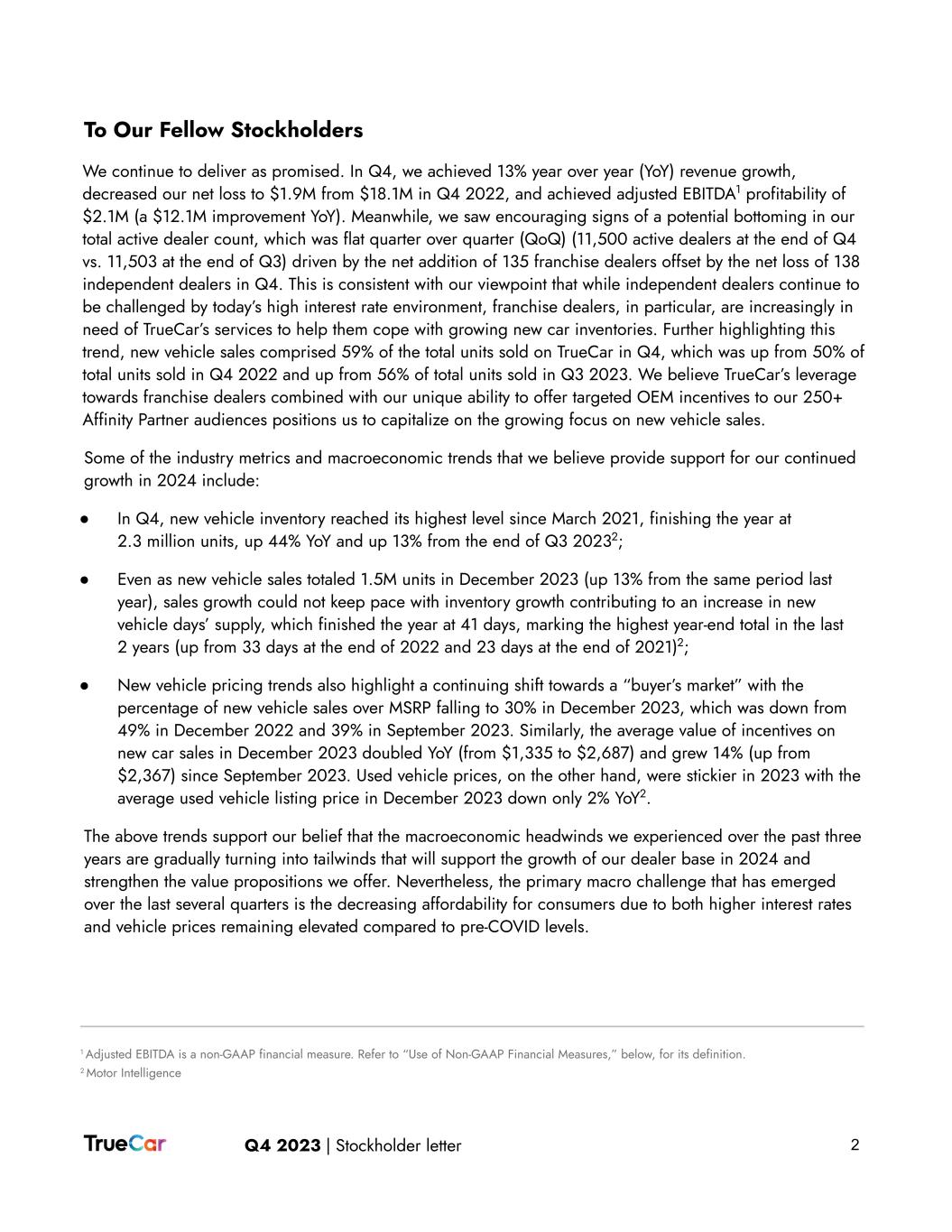
Q4 2023 | Stockholder letter To Our Fellow Stockholders We continue to deliver as promised. In Q4, we achieved 13% year over year (YoY) revenue growth, decreased our net loss to $1.9M from $18.1M in Q4 2022, and achieved adjusted EBITDA1 profitability of $2.1M (a $12.1M improvement YoY). Meanwhile, we saw encouraging signs of a potential bottoming in our total active dealer count, which was flat quarter over quarter (QoQ) (11,500 active dealers at the end of Q4 vs. 11,503 at the end of Q3) driven by the net addition of 135 franchise dealers offset by the net loss of 138 independent dealers in Q4. This is consistent with our viewpoint that while independent dealers continue to be challenged by today’s high interest rate environment, franchise dealers, in particular, are increasingly in need of TrueCar’s services to help them cope with growing new car inventories. Further highlighting this trend, new vehicle sales comprised 59% of the total units sold on TrueCar in Q4, which was up from 50% of total units sold in Q4 2022 and up from 56% of total units sold in Q3 2023. We believe TrueCar’s leverage towards franchise dealers combined with our unique ability to offer targeted OEM incentives to our 250+ Affinity Partner audiences positions us to capitalize on the growing focus on new vehicle sales. Some of the industry metrics and macroeconomic trends that we believe provide support for our continued growth in 2024 include: ● In Q4, new vehicle inventory reached its highest level since March 2021, finishing the year at 2.3 million units, up 44% YoY and up 13% from the end of Q3 20232; ● Even as new vehicle sales totaled 1.5M units in December 2023 (up 13% from the same period last year), sales growth could not keep pace with inventory growth contributing to an increase in new vehicle days’ supply, which finished the year at 41 days, marking the highest year-end total in the last 2 years (up from 33 days at the end of 2022 and 23 days at the end of 2021)2; ● New vehicle pricing trends also highlight a continuing shift towards a “buyer’s market” with the percentage of new vehicle sales over MSRP falling to 30% in December 2023, which was down from 49% in December 2022 and 39% in September 2023. Similarly, the average value of incentives on new car sales in December 2023 doubled YoY (from $1,335 to $2,687) and grew 14% (up from $2,367) since September 2023. Used vehicle prices, on the other hand, were stickier in 2023 with the average used vehicle listing price in December 2023 down only 2% YoY2. The above trends support our belief that the macroeconomic headwinds we experienced over the past three years are gradually turning into tailwinds that will support the growth of our dealer base in 2024 and strengthen the value propositions we offer. Nevertheless, the primary macro challenge that has emerged over the last several quarters is the decreasing affordability for consumers due to both higher interest rates and vehicle prices remaining elevated compared to pre-COVID levels. 2 1 Adjusted EBITDA is a non-GAAP financial measure. Refer to “Use of Non-GAAP Financial Measures,” below, for its definition. 2 Motor Intelligence
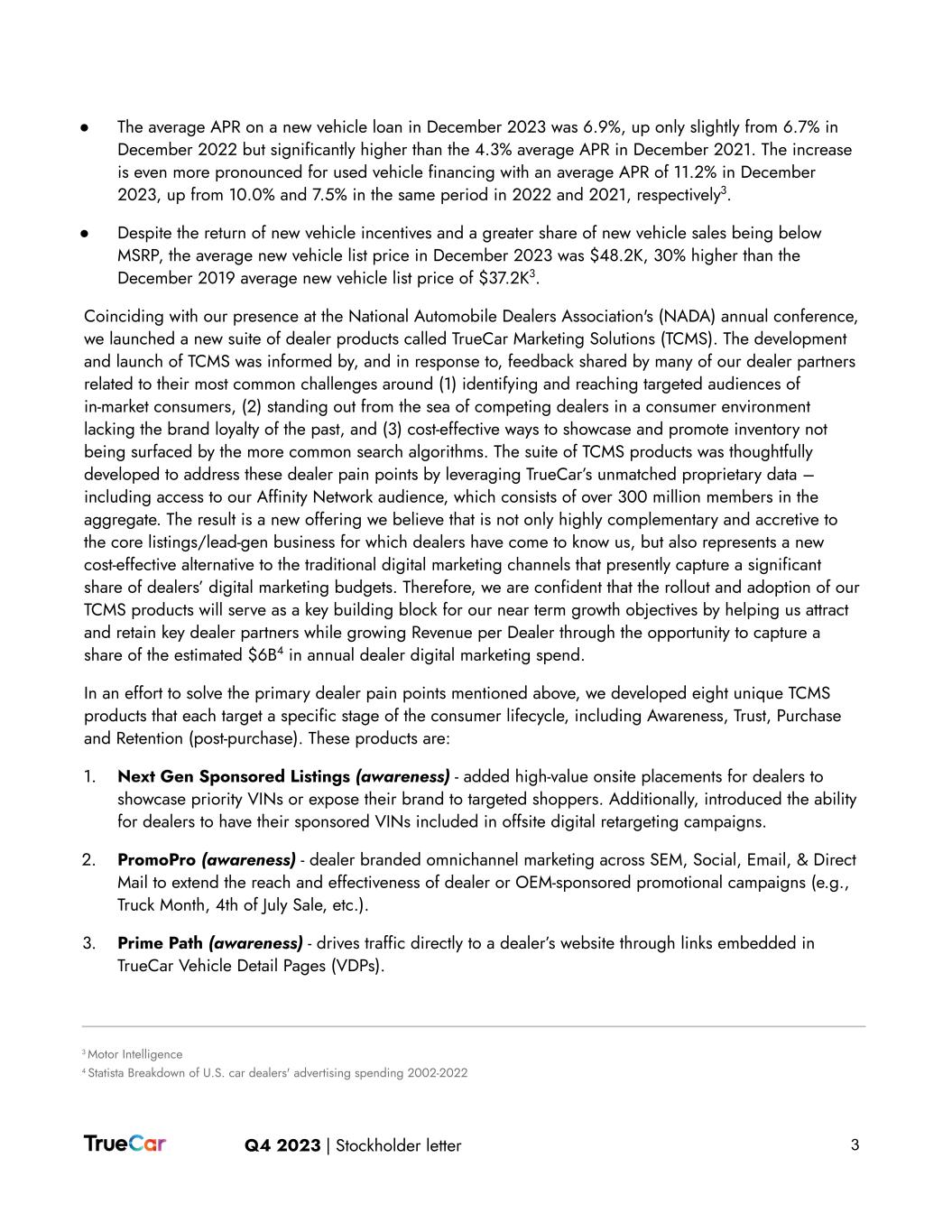
Q4 2023 | Stockholder letter ● The average APR on a new vehicle loan in December 2023 was 6.9%, up only slightly from 6.7% in December 2022 but significantly higher than the 4.3% average APR in December 2021. The increase is even more pronounced for used vehicle financing with an average APR of 11.2% in December 2023, up from 10.0% and 7.5% in the same period in 2022 and 2021, respectively3. ● Despite the return of new vehicle incentives and a greater share of new vehicle sales being below MSRP, the average new vehicle list price in December 2023 was $48.2K, 30% higher than the December 2019 average new vehicle list price of $37.2K3. Coinciding with our presence at the National Automobile Dealers Association's (NADA) annual conference, we launched a new suite of dealer products called TrueCar Marketing Solutions (TCMS). The development and launch of TCMS was informed by, and in response to, feedback shared by many of our dealer partners related to their most common challenges around (1) identifying and reaching targeted audiences of in-market consumers, (2) standing out from the sea of competing dealers in a consumer environment lacking the brand loyalty of the past, and (3) cost-effective ways to showcase and promote inventory not being surfaced by the more common search algorithms. The suite of TCMS products was thoughtfully developed to address these dealer pain points by leveraging TrueCar’s unmatched proprietary data – including access to our Affinity Network audience, which consists of over 300 million members in the aggregate. The result is a new offering we believe that is not only highly complementary and accretive to the core listings/lead-gen business for which dealers have come to know us, but also represents a new cost-effective alternative to the traditional digital marketing channels that presently capture a significant share of dealers’ digital marketing budgets. Therefore, we are confident that the rollout and adoption of our TCMS products will serve as a key building block for our near term growth objectives by helping us attract and retain key dealer partners while growing Revenue per Dealer through the opportunity to capture a share of the estimated $6B4 in annual dealer digital marketing spend. In an effort to solve the primary dealer pain points mentioned above, we developed eight unique TCMS products that each target a specific stage of the consumer lifecycle, including Awareness, Trust, Purchase and Retention (post-purchase). These products are: 1. Next Gen Sponsored Listings (awareness) - added high-value onsite placements for dealers to showcase priority VINs or expose their brand to targeted shoppers. Additionally, introduced the ability for dealers to have their sponsored VINs included in offsite digital retargeting campaigns. 2. PromoPro (awareness) - dealer branded omnichannel marketing across SEM, Social, Email, & Direct Mail to extend the reach and effectiveness of dealer or OEM-sponsored promotional campaigns (e.g., Truck Month, 4th of July Sale, etc.). 3. Prime Path (awareness) - drives traffic directly to a dealer’s website through links embedded in TrueCar Vehicle Detail Pages (VDPs). 3 3 Motor Intelligence 4 Statista Breakdown of U.S. car dealers' advertising spending 2002-2022
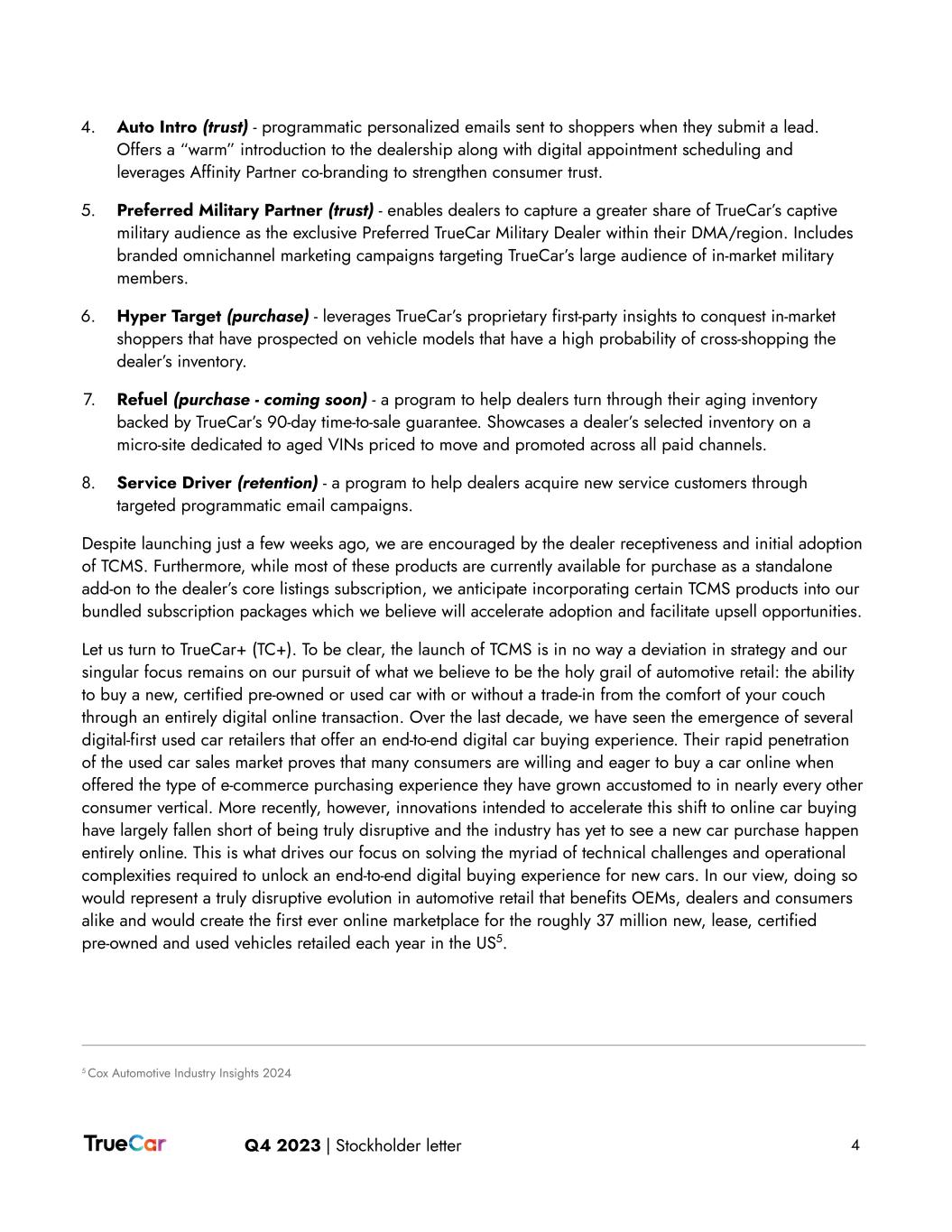
Q4 2023 | Stockholder letter 4. Auto Intro (trust) - programmatic personalized emails sent to shoppers when they submit a lead. Offers a “warm” introduction to the dealership along with digital appointment scheduling and leverages Affinity Partner co-branding to strengthen consumer trust. 5. Preferred Military Partner (trust) - enables dealers to capture a greater share of TrueCar’s captive military audience as the exclusive Preferred TrueCar Military Dealer within their DMA/region. Includes branded omnichannel marketing campaigns targeting TrueCar’s large audience of in-market military members. 6. Hyper Target (purchase) - leverages TrueCar’s proprietary first-party insights to conquest in-market shoppers that have prospected on vehicle models that have a high probability of cross-shopping the dealer’s inventory. 7. Refuel (purchase - coming soon) - a program to help dealers turn through their aging inventory backed by TrueCar’s 90-day time-to-sale guarantee. Showcases a dealer’s selected inventory on a micro-site dedicated to aged VINs priced to move and promoted across all paid channels. 8. Service Driver (retention) - a program to help dealers acquire new service customers through targeted programmatic email campaigns. Despite launching just a few weeks ago, we are encouraged by the dealer receptiveness and initial adoption of TCMS. Furthermore, while most of these products are currently available for purchase as a standalone add-on to the dealer’s core listings subscription, we anticipate incorporating certain TCMS products into our bundled subscription packages which we believe will accelerate adoption and facilitate upsell opportunities. Let us turn to TrueCar+ (TC+). To be clear, the launch of TCMS is in no way a deviation in strategy and our singular focus remains on our pursuit of what we believe to be the holy grail of automotive retail: the ability to buy a new, certified pre-owned or used car with or without a trade-in from the comfort of your couch through an entirely digital online transaction. Over the last decade, we have seen the emergence of several digital-first used car retailers that offer an end-to-end digital car buying experience. Their rapid penetration of the used car sales market proves that many consumers are willing and eager to buy a car online when offered the type of e-commerce purchasing experience they have grown accustomed to in nearly every other consumer vertical. More recently, however, innovations intended to accelerate this shift to online car buying have largely fallen short of being truly disruptive and the industry has yet to see a new car purchase happen entirely online. This is what drives our focus on solving the myriad of technical challenges and operational complexities required to unlock an end-to-end digital buying experience for new cars. In our view, doing so would represent a truly disruptive evolution in automotive retail that benefits OEMs, dealers and consumers alike and would create the first ever online marketplace for the roughly 37 million new, lease, certified pre-owned and used vehicles retailed each year in the US5. 5 Cox Automotive Industry Insights 2024 4
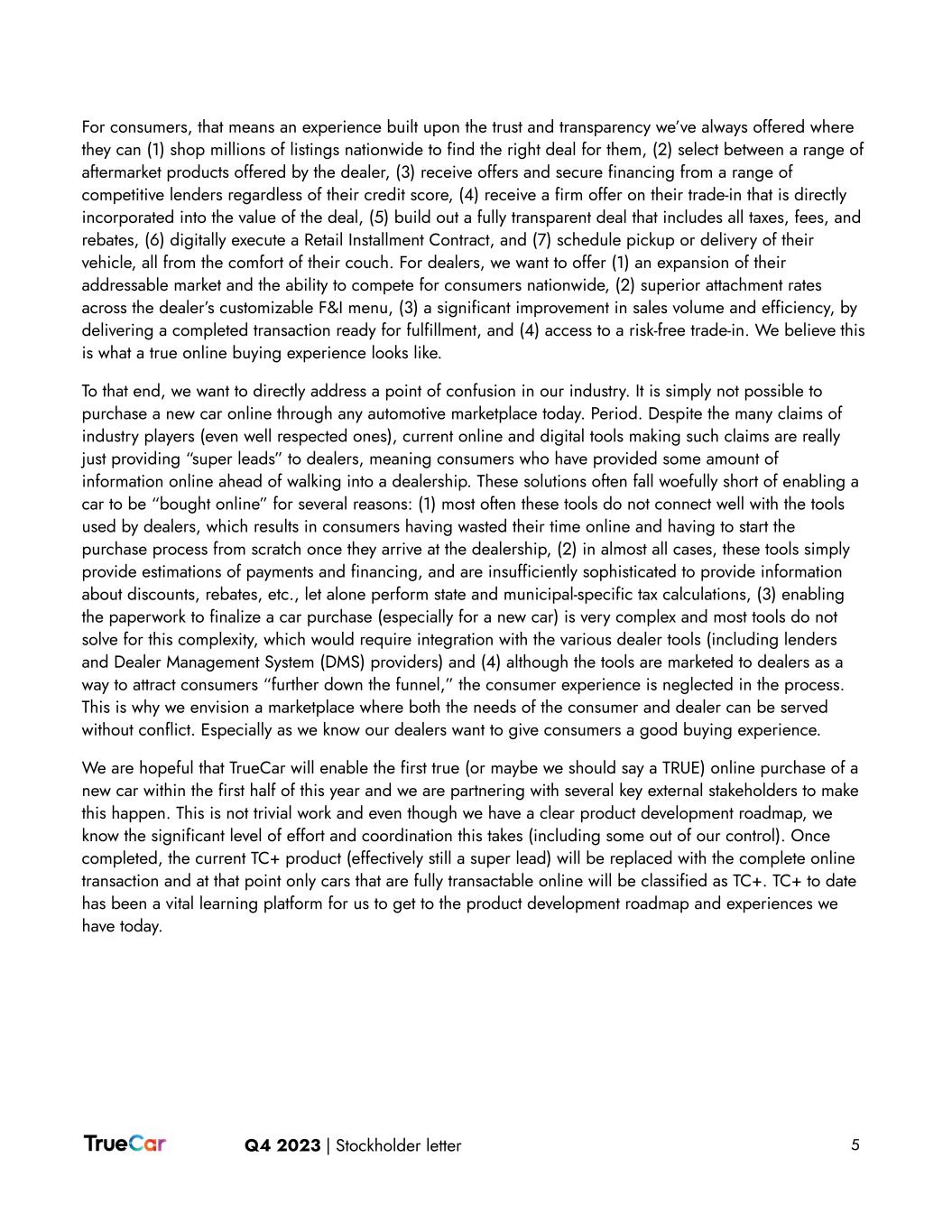
Q4 2023 | Stockholder letter For consumers, that means an experience built upon the trust and transparency we’ve always offered where they can (1) shop millions of listings nationwide to find the right deal for them, (2) select between a range of aftermarket products offered by the dealer, (3) receive offers and secure financing from a range of competitive lenders regardless of their credit score, (4) receive a firm offer on their trade-in that is directly incorporated into the value of the deal, (5) build out a fully transparent deal that includes all taxes, fees, and rebates, (6) digitally execute a Retail Installment Contract, and (7) schedule pickup or delivery of their vehicle, all from the comfort of their couch. For dealers, we want to offer (1) an expansion of their addressable market and the ability to compete for consumers nationwide, (2) superior attachment rates across the dealer’s customizable F&I menu, (3) a significant improvement in sales volume and efficiency, by delivering a completed transaction ready for fulfillment, and (4) access to a risk-free trade-in. We believe this is what a true online buying experience looks like. To that end, we want to directly address a point of confusion in our industry. It is simply not possible to purchase a new car online through any automotive marketplace today. Period. Despite the many claims of industry players (even well respected ones), current online and digital tools making such claims are really just providing “super leads” to dealers, meaning consumers who have provided some amount of information online ahead of walking into a dealership. These solutions often fall woefully short of enabling a car to be “bought online” for several reasons: (1) most often these tools do not connect well with the tools used by dealers, which results in consumers having wasted their time online and having to start the purchase process from scratch once they arrive at the dealership, (2) in almost all cases, these tools simply provide estimations of payments and financing, and are insufficiently sophisticated to provide information about discounts, rebates, etc., let alone perform state and municipal-specific tax calculations, (3) enabling the paperwork to finalize a car purchase (especially for a new car) is very complex and most tools do not solve for this complexity, which would require integration with the various dealer tools (including lenders and Dealer Management System (DMS) providers) and (4) although the tools are marketed to dealers as a way to attract consumers “further down the funnel,” the consumer experience is neglected in the process. This is why we envision a marketplace where both the needs of the consumer and dealer can be served without conflict. Especially as we know our dealers want to give consumers a good buying experience. We are hopeful that TrueCar will enable the first true (or maybe we should say a TRUE) online purchase of a new car within the first half of this year and we are partnering with several key external stakeholders to make this happen. This is not trivial work and even though we have a clear product development roadmap, we know the significant level of effort and coordination this takes (including some out of our control). Once completed, the current TC+ product (effectively still a super lead) will be replaced with the complete online transaction and at that point only cars that are fully transactable online will be classified as TC+. TC+ to date has been a vital learning platform for us to get to the product development roadmap and experiences we have today. 5
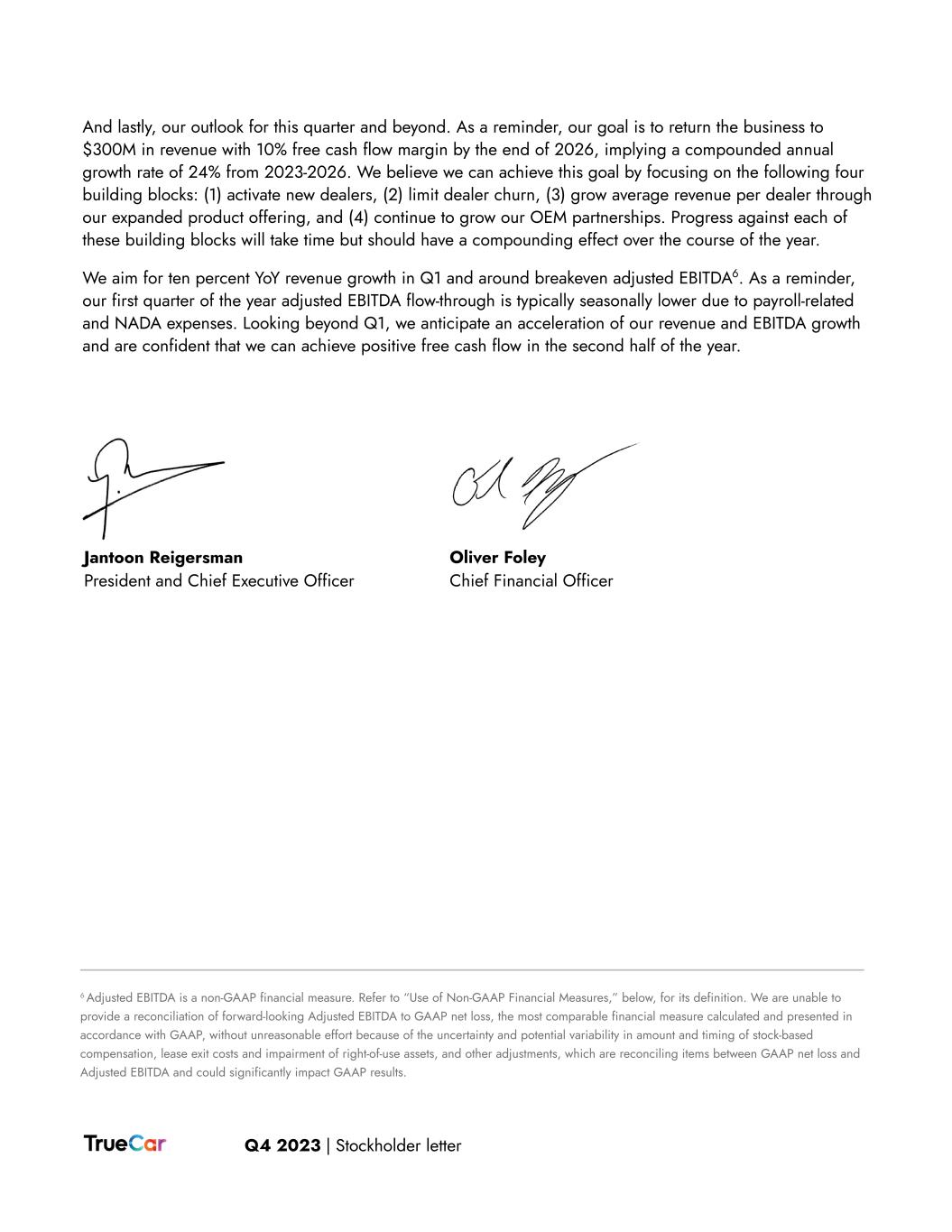
Q4 2023 | Stockholder letter Jantoon Reigersman President and Chief Executive Officer Oliver Foley Chief Financial Officer And lastly, our outlook for this quarter and beyond. As a reminder, our goal is to return the business to $300M in revenue with 10% free cash flow margin by the end of 2026, implying a compounded annual growth rate of 24% from 2023-2026. We believe we can achieve this goal by focusing on the following four building blocks: (1) activate new dealers, (2) limit dealer churn, (3) grow average revenue per dealer through our expanded product offering, and (4) continue to grow our OEM partnerships. Progress against each of these building blocks will take time but should have a compounding effect over the course of the year. We aim for ten percent YoY revenue growth in Q1 and around breakeven adjusted EBITDA6. As a reminder, our first quarter of the year adjusted EBITDA flow-through is typically seasonally lower due to payroll-related and NADA expenses. Looking beyond Q1, we anticipate an acceleration of our revenue and EBITDA growth and are confident that we can achieve positive free cash flow in the second half of the year. 6 Adjusted EBITDA is a non-GAAP financial measure. Refer to “Use of Non-GAAP Financial Measures,” below, for its definition. We are unable to provide a reconciliation of forward-looking Adjusted EBITDA to GAAP net loss, the most comparable financial measure calculated and presented in accordance with GAAP, without unreasonable effort because of the uncertainty and potential variability in amount and timing of stock-based compensation, lease exit costs and impairment of right-of-use assets, and other adjustments, which are reconciling items between GAAP net loss and Adjusted EBITDA and could significantly impact GAAP results.
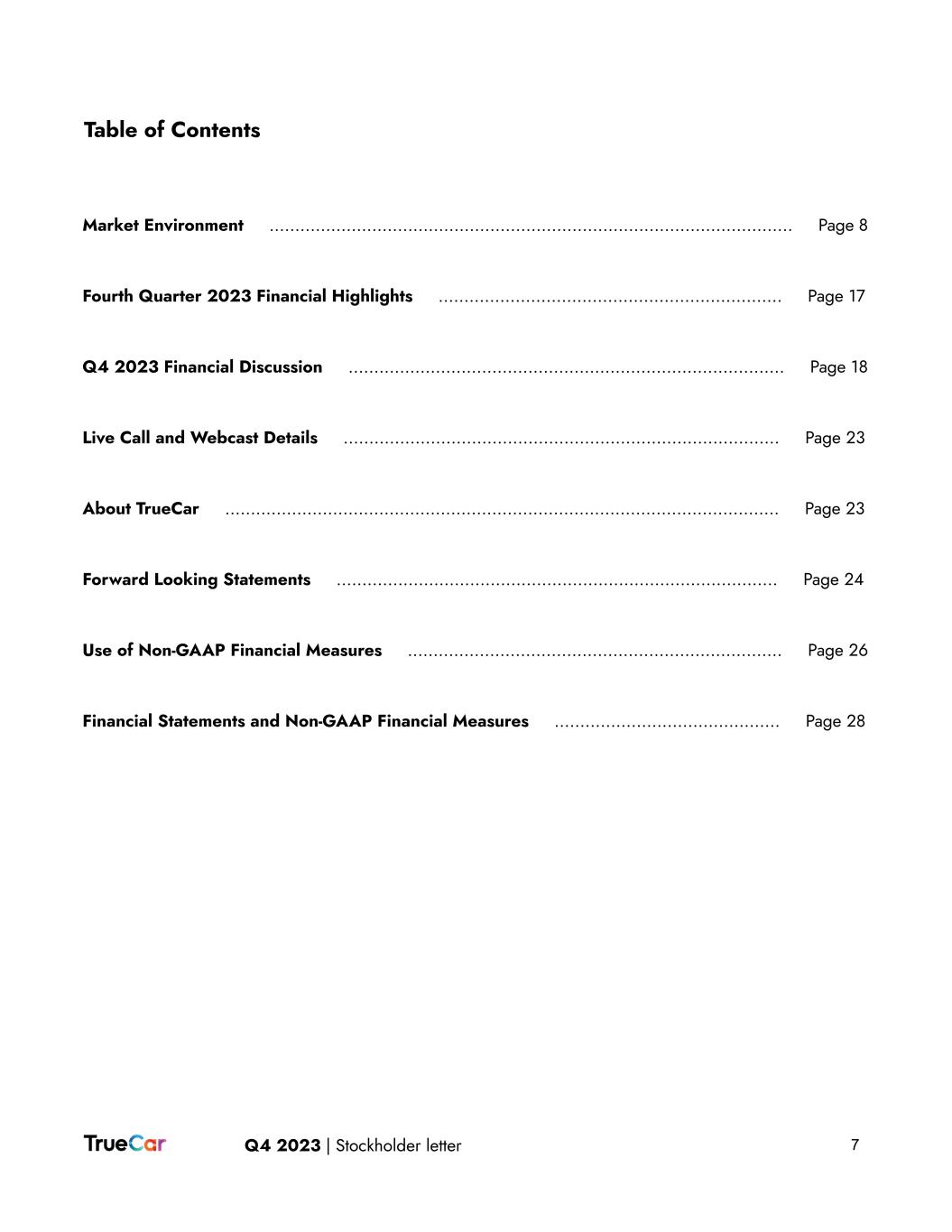
Q4 2023 | Stockholder letter Table of Contents Market Environment ……………………………………………..……………………………..………..… Page 8 Fourth Quarter 2023 Financial Highlights ………………….…………….……………………..… Page 17 Q4 2023 Financial Discussion …………………………………………………….………..…..…..… Page 18 Live Call and Webcast Details ……………….………………………………………….…………..… Page 23 About TrueCar …………………………………………………………………………………...….…..… Page 23 Forward Looking Statements …………………………………………….……….………….……..… Page 24 Use of Non-GAAP Financial Measures ………………………………………….….……………..… Page 26 Financial Statements and Non-GAAP Financial Measures ……………………………..……… Page 28 7

Q4 2023 | Stockholder letter 8 Market Environment New vehicle inventory continued its steady rise, peaking in November 2023 with 2.32 million units before settling at 2.28 million units in December 2023. Despite continued concerns about affordability, we saw slight improvement QoQ with an 8.6% decrease in interest rates for new vehicles in December 2023 compared to September 2023. Additionally, the average days’ supply for new vehicles peaked at 44 and 47 days in October and November, respectively, before leveling off at 41 days in December. Q4 2023 marked its peak, reaching levels not seen since Q1 2021. As mentioned above, new vehicle inventory rose to 2.28 million units in December 2023, up 44% or approximately 697 thousand units from December 2022, and up 13% or 260 thousand units from September 2023. This marked the first time new inventory rose above 2.2 million since March 2021. Source: Motor Intelligence NEW VEHICLE INVENTORY (Industry) 2.28M YoY 44%
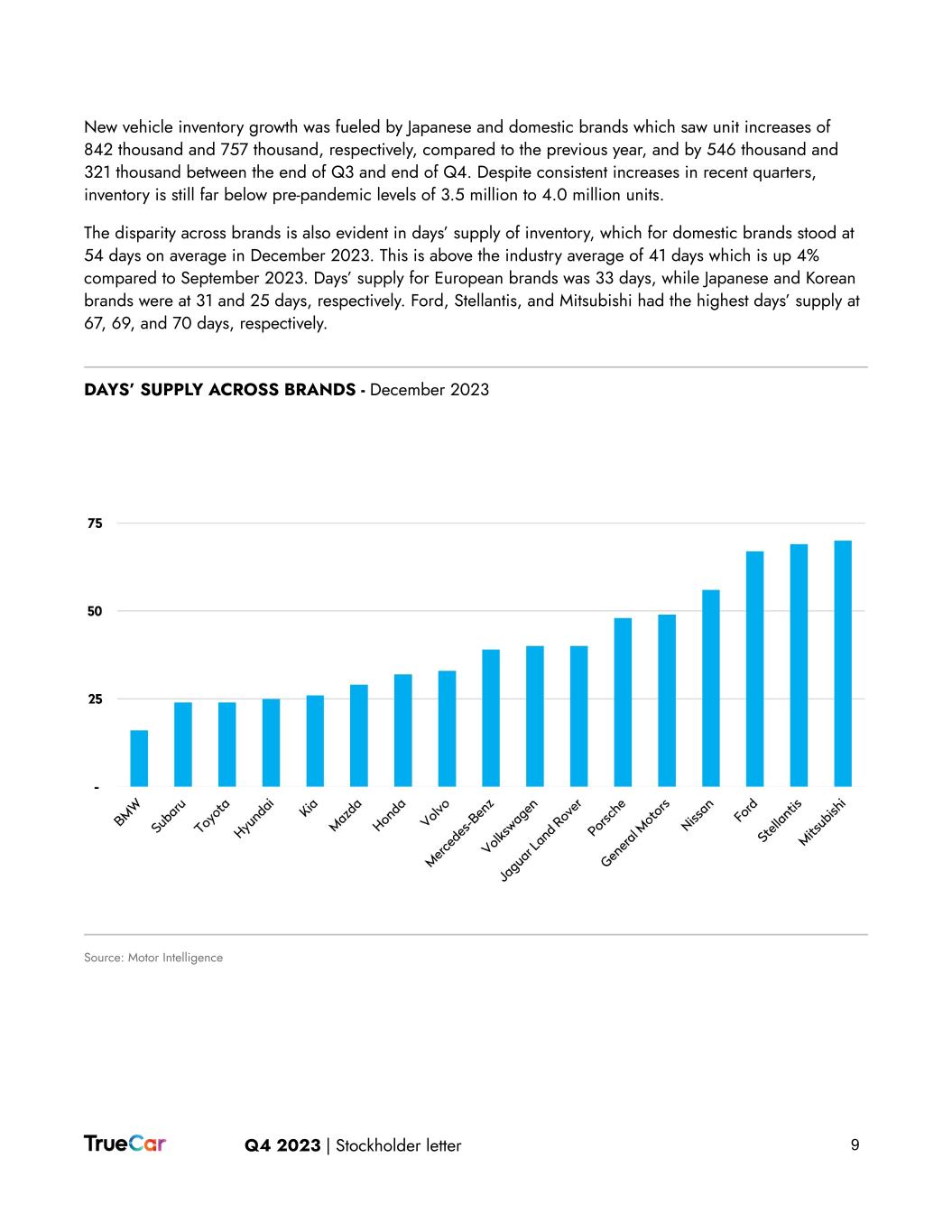
Q4 2023 | Stockholder letter 9 New vehicle inventory growth was fueled by Japanese and domestic brands which saw unit increases of 842 thousand and 757 thousand, respectively, compared to the previous year, and by 546 thousand and 321 thousand between the end of Q3 and end of Q4. Despite consistent increases in recent quarters, inventory is still far below pre-pandemic levels of 3.5 million to 4.0 million units. The disparity across brands is also evident in days’ supply of inventory, which for domestic brands stood at 54 days on average in December 2023. This is above the industry average of 41 days which is up 4% compared to September 2023. Days’ supply for European brands was 33 days, while Japanese and Korean brands were at 31 and 25 days, respectively. Ford, Stellantis, and Mitsubishi had the highest days’ supply at 67, 69, and 70 days, respectively. DAYS’ SUPPLY ACROSS BRANDS - December 2023 Source: Motor Intelligence
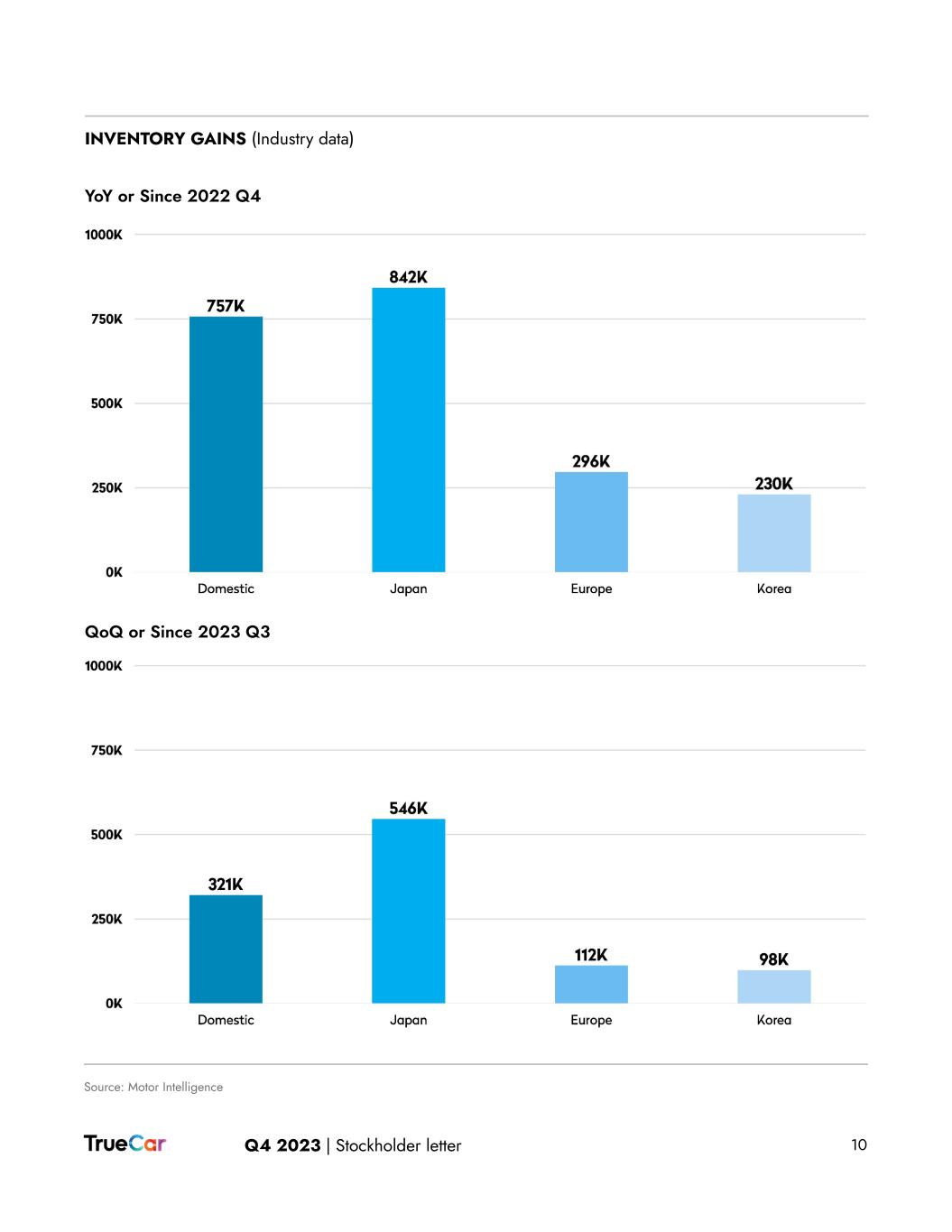
Q4 2023 | Stockholder letter 10 INVENTORY GAINS (Industry data) Source: Motor Intelligence YoY or Since 2022 Q4 QoQ or Since 2023 Q3
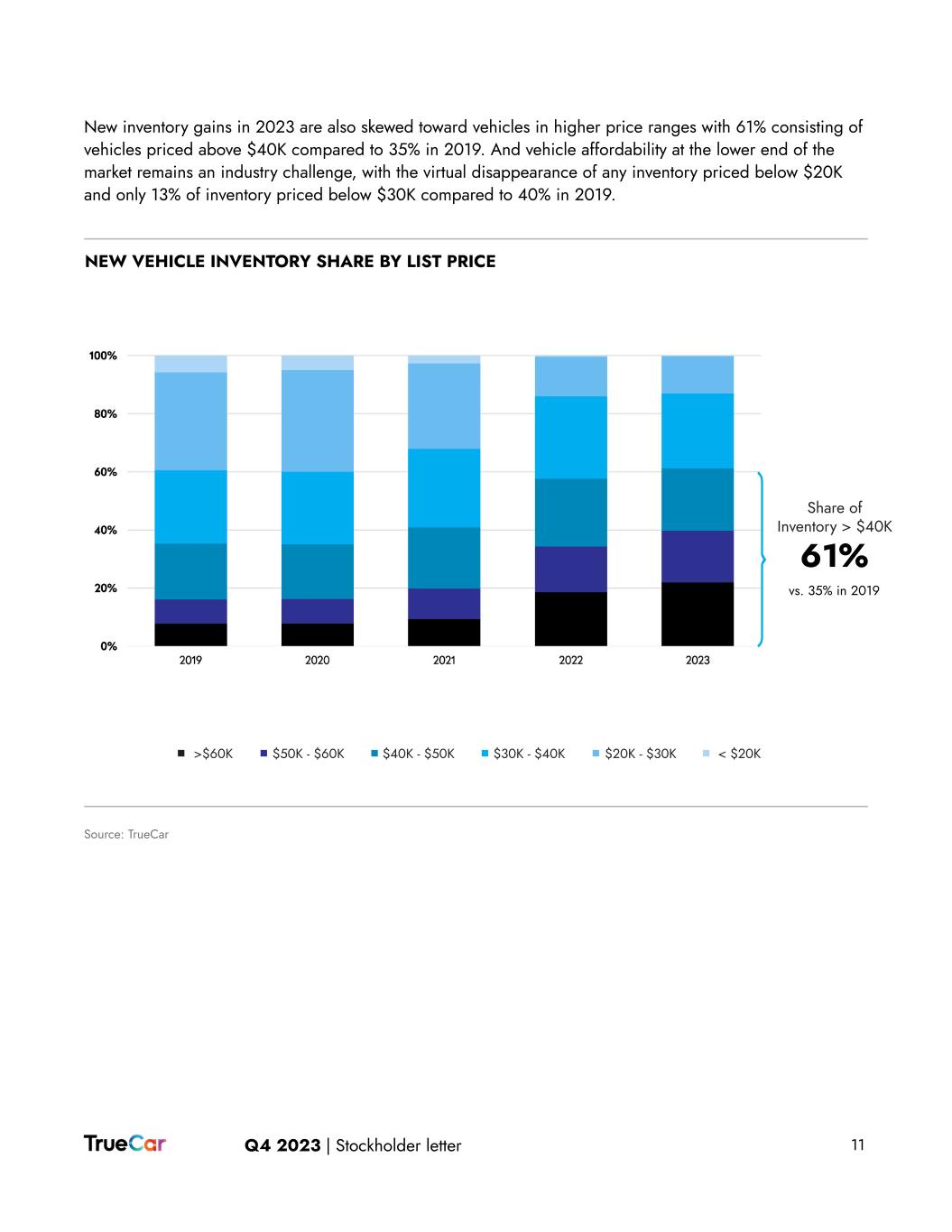
Q4 2023 | Stockholder letter 11 New inventory gains in 2023 are also skewed toward vehicles in higher price ranges with 61% consisting of vehicles priced above $40K compared to 35% in 2019. And vehicle affordability at the lower end of the market remains an industry challenge, with the virtual disappearance of any inventory priced below $20K and only 13% of inventory priced below $30K compared to 40% in 2019. >$60K $50K - $60K $40K - $50K $30K - $40K $20K - $30K < $20K Source: TrueCar NEW VEHICLE INVENTORY SHARE BY LIST PRICE Share of Inventory > $40K 61% vs. 35% in 2019
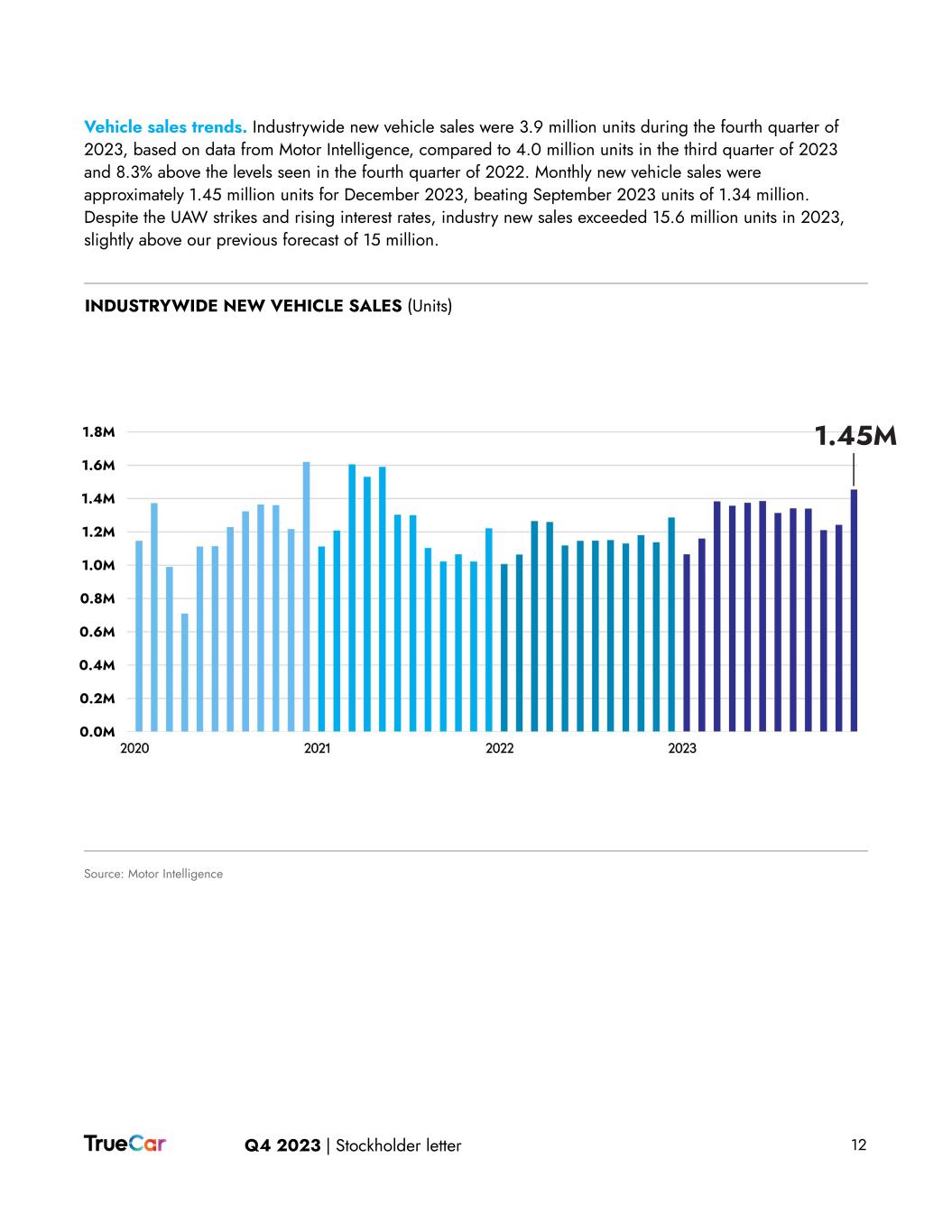
Q4 2023 | Stockholder letter Vehicle sales trends. Industrywide new vehicle sales were 3.9 million units during the fourth quarter of 2023, based on data from Motor Intelligence, compared to 4.0 million units in the third quarter of 2023 and 8.3% above the levels seen in the fourth quarter of 2022. Monthly new vehicle sales were approximately 1.45 million units for December 2023, beating September 2023 units of 1.34 million. Despite the UAW strikes and rising interest rates, industry new sales exceeded 15.6 million units in 2023, slightly above our previous forecast of 15 million. 12 INDUSTRYWIDE NEW VEHICLE SALES (Units) Source: Motor Intelligence 1.45M1.8M 1.6M 1.4M 1.2M 1.0M 0.8M 0.6M 0.4M 0.2M 0.0M

Q4 2023 | Stockholder letter On average, the supply of new vehicles has continued to improve slightly for the industry, however, as we observed earlier, this progress is still not widespread with gains mainly seen for domestic brands while shortages continued as of December 2023 for certain brands like BMW, Subaru, Toyota, Hyundai, and Kia. 13 The seasonally adjusted annual rate (SAAR) for the end of December 2023 was 15.9 million, which is up from 13.6 million at the end of December 2022, but is slightly below the 2023 peak of 16.1 million at the end of June 2023. LIGHT VEHICLE SEASONALLY ADJUSTED ANNUAL RATE (SAAR) Source: U.S. Bureau of Economic Analysis 15.9M 20.0M 18.0M 16.0M 14.0M 12.0M 10.0M 8.0M 6.0M 4.0M 2.0M 0.0M
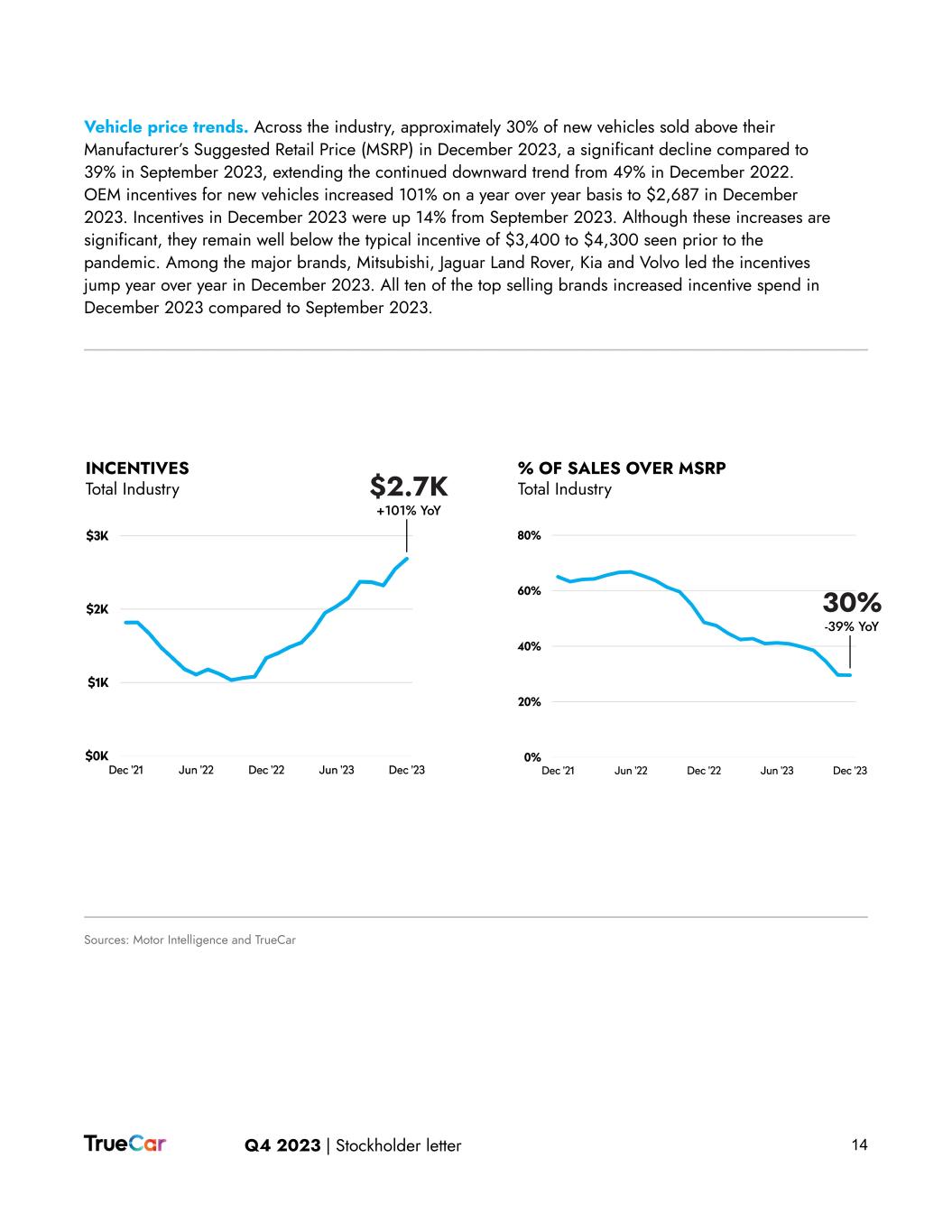
Q4 2023 | Stockholder letter Vehicle price trends. Across the industry, approximately 30% of new vehicles sold above their Manufacturer’s Suggested Retail Price (MSRP) in December 2023, a significant decline compared to 39% in September 2023, extending the continued downward trend from 49% in December 2022. OEM incentives for new vehicles increased 101% on a year over year basis to $2,687 in December 2023. Incentives in December 2023 were up 14% from September 2023. Although these increases are significant, they remain well below the typical incentive of $3,400 to $4,300 seen prior to the pandemic. Among the major brands, Mitsubishi, Jaguar Land Rover, Kia and Volvo led the incentives jump year over year in December 2023. All ten of the top selling brands increased incentive spend in December 2023 compared to September 2023. 14 Sources: Motor Intelligence and TrueCar INCENTIVES Total Industry % OF SALES OVER MSRP Total Industry$2.7K +101% YoY 30% -39% YoY
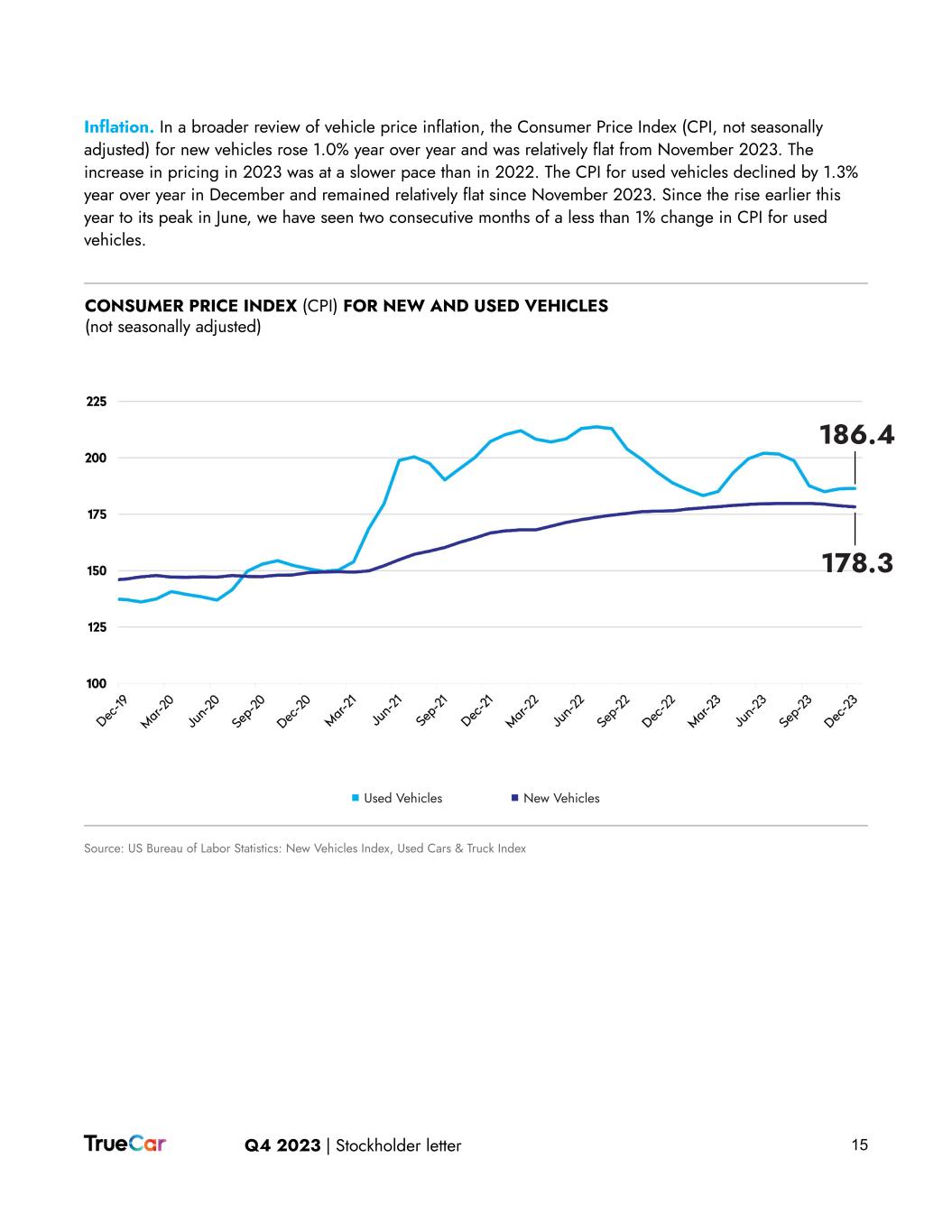
Q4 2023 | Stockholder letter Inflation. In a broader review of vehicle price inflation, the Consumer Price Index (CPI, not seasonally adjusted) for new vehicles rose 1.0% year over year and was relatively flat from November 2023. The increase in pricing in 2023 was at a slower pace than in 2022. The CPI for used vehicles declined by 1.3% year over year in December and remained relatively flat since November 2023. Since the rise earlier this year to its peak in June, we have seen two consecutive months of a less than 1% change in CPI for used vehicles. 15 Source: US Bureau of Labor Statistics: New Vehicles Index, Used Cars & Truck Index CONSUMER PRICE INDEX (CPI) FOR NEW AND USED VEHICLES (not seasonally adjusted) Used Vehicles New Vehicles 186.4 178.3
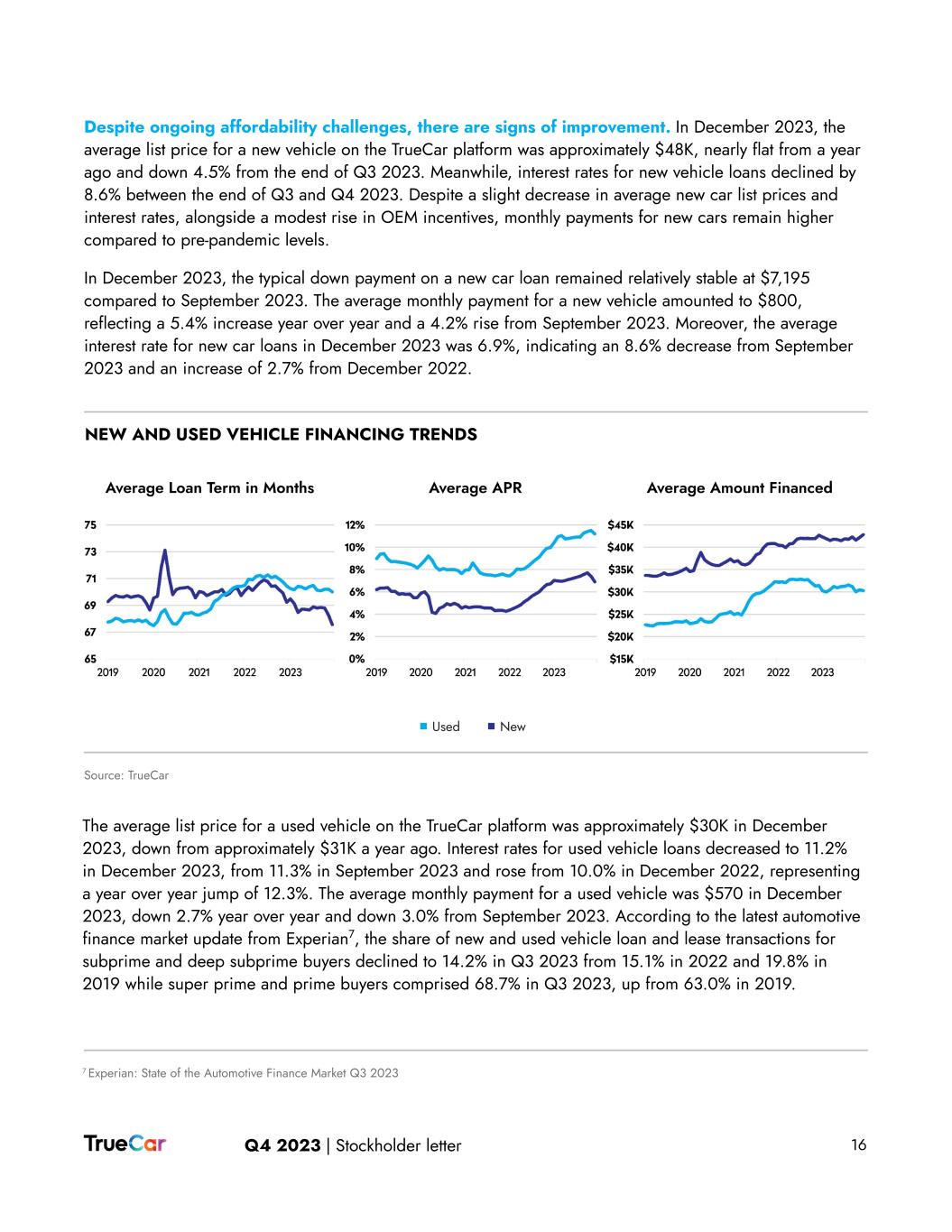
Q4 2023 | Stockholder letter Despite ongoing affordability challenges, there are signs of improvement. In December 2023, the average list price for a new vehicle on the TrueCar platform was approximately $48K, nearly flat from a year ago and down 4.5% from the end of Q3 2023. Meanwhile, interest rates for new vehicle loans declined by 8.6% between the end of Q3 and Q4 2023. Despite a slight decrease in average new car list prices and interest rates, alongside a modest rise in OEM incentives, monthly payments for new cars remain higher compared to pre-pandemic levels. In December 2023, the typical down payment on a new car loan remained relatively stable at $7,195 compared to September 2023. The average monthly payment for a new vehicle amounted to $800, reflecting a 5.4% increase year over year and a 4.2% rise from September 2023. Moreover, the average interest rate for new car loans in December 2023 was 6.9%, indicating an 8.6% decrease from September 2023 and an increase of 2.7% from December 2022. 16 7 Experian: State of the Automotive Finance Market Q3 2023 NEW AND USED VEHICLE FINANCING TRENDS Source: TrueCar Used New Average Loan Term in Months Average APR Average Amount Financed The average list price for a used vehicle on the TrueCar platform was approximately $30K in December 2023, down from approximately $31K a year ago. Interest rates for used vehicle loans decreased to 11.2% in December 2023, from 11.3% in September 2023 and rose from 10.0% in December 2022, representing a year over year jump of 12.3%. The average monthly payment for a used vehicle was $570 in December 2023, down 2.7% year over year and down 3.0% from September 2023. According to the latest automotive finance market update from Experian7, the share of new and used vehicle loan and lease transactions for subprime and deep subprime buyers declined to 14.2% in Q3 2023 from 15.1% in 2022 and 19.8% in 2019 while super prime and prime buyers comprised 68.7% in Q3 2023, up from 63.0% in 2019.
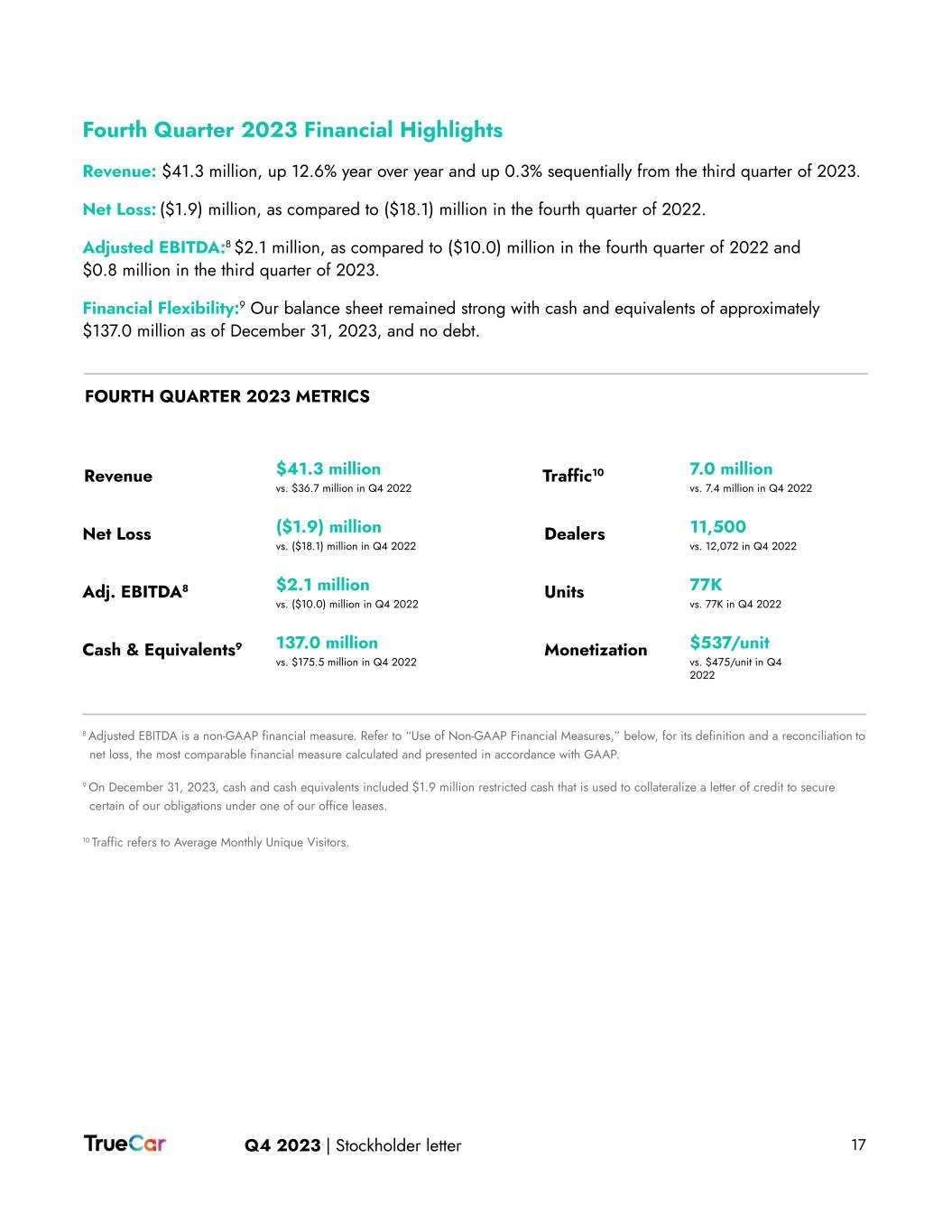
Q4 2023 | Stockholder letter 17 Fourth Quarter 2023 Financial Highlights Revenue: $41.3 million, up 12.6% year over year and up 0.3% sequentially from the third quarter of 2023. Net Loss: ($1.9) million, as compared to ($18.1) million in the fourth quarter of 2022. Adjusted EBITDA:8 $2.1 million, as compared to ($10.0) million in the fourth quarter of 2022 and $0.8 million in the third quarter of 2023. Financial Flexibility:9 Our balance sheet remained strong with cash and equivalents of approximately $137.0 million as of December 31, 2023, and no debt. Revenue $41.3 million vs. $36.7 million in Q4 2022 Traffic10 7.0 million vs. 7.4 million in Q4 2022 Net Loss ($1.9) million vs. ($18.1) million in Q4 2022 Dealers 11,500 vs. 12,072 in Q4 2022 Adj. EBITDA8 $2.1 million vs. ($10.0) million in Q4 2022 Units 77K vs. 77K in Q4 2022 Cash & Equivalents9 137.0 million vs. $175.5 million in Q4 2022 Monetization $537/unit vs. $475/unit in Q4 2022 8 Adjusted EBITDA is a non-GAAP financial measure. Refer to “Use of Non-GAAP Financial Measures,” below, for its definition and a reconciliation to net loss, the most comparable financial measure calculated and presented in accordance with GAAP. 9 On December 31, 2023, cash and cash equivalents included $1.9 million restricted cash that is used to collateralize a letter of credit to secure certain of our obligations under one of our office leases. 10 Traffic refers to Average Monthly Unique Visitors. FOURTH QUARTER 2023 METRICS
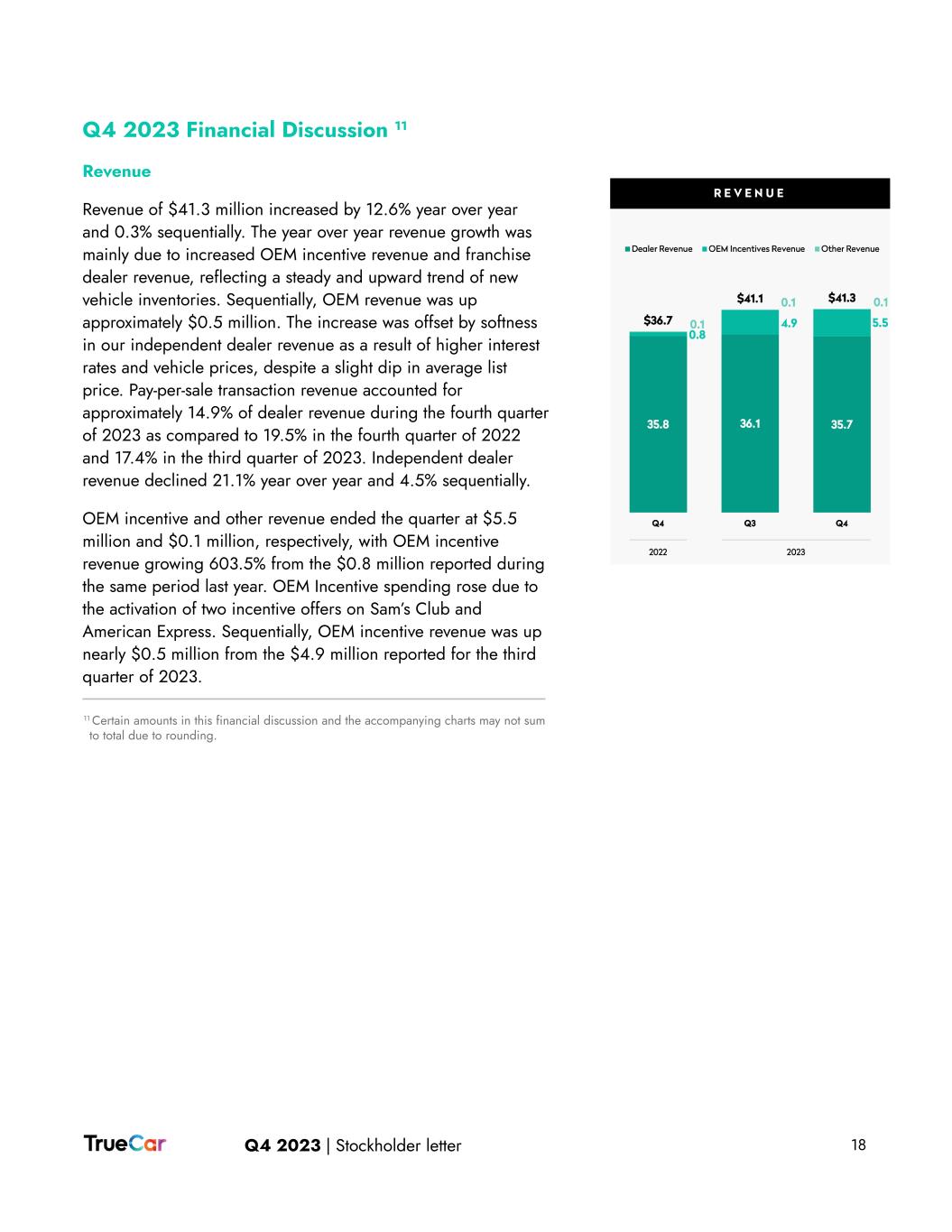
Q4 2023 | Stockholder letter 11 Certain amounts in this financial discussion and the accompanying charts may not sum to total due to rounding. 18 Q4 2023 Financial Discussion 11 Revenue Revenue of $41.3 million increased by 12.6% year over year and 0.3% sequentially. The year over year revenue growth was mainly due to increased OEM incentive revenue and franchise dealer revenue, reflecting a steady and upward trend of new vehicle inventories. Sequentially, OEM revenue was up approximately $0.5 million. The increase was offset by softness in our independent dealer revenue as a result of higher interest rates and vehicle prices, despite a slight dip in average list price. Pay-per-sale transaction revenue accounted for approximately 14.9% of dealer revenue during the fourth quarter of 2023 as compared to 19.5% in the fourth quarter of 2022 and 17.4% in the third quarter of 2023. Independent dealer revenue declined 21.1% year over year and 4.5% sequentially. OEM incentive and other revenue ended the quarter at $5.5 million and $0.1 million, respectively, with OEM incentive revenue growing 603.5% from the $0.8 million reported during the same period last year. OEM Incentive spending rose due to the activation of two incentive offers on Sam’s Club and American Express. Sequentially, OEM incentive revenue was up nearly $0.5 million from the $4.9 million reported for the third quarter of 2023.
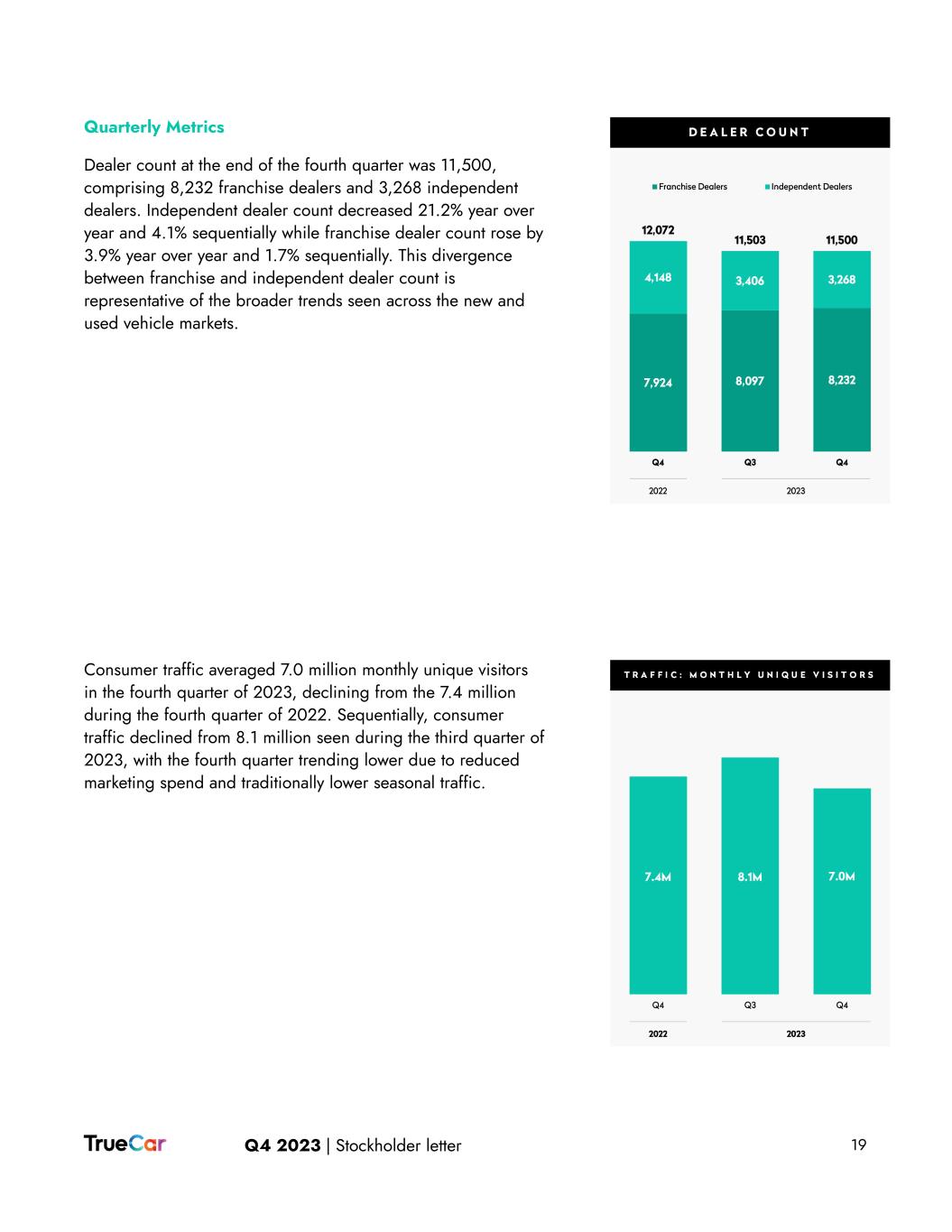
Q4 2023 | Stockholder letter Quarterly Metrics Dealer count at the end of the fourth quarter was 11,500, comprising 8,232 franchise dealers and 3,268 independent dealers. Independent dealer count decreased 21.2% year over year and 4.1% sequentially while franchise dealer count rose by 3.9% year over year and 1.7% sequentially. This divergence between franchise and independent dealer count is representative of the broader trends seen across the new and used vehicle markets. Consumer traffic averaged 7.0 million monthly unique visitors in the fourth quarter of 2023, declining from the 7.4 million during the fourth quarter of 2022. Sequentially, consumer traffic declined from 8.1 million seen during the third quarter of 2023, with the fourth quarter trending lower due to reduced marketing spend and traditionally lower seasonal traffic. 19
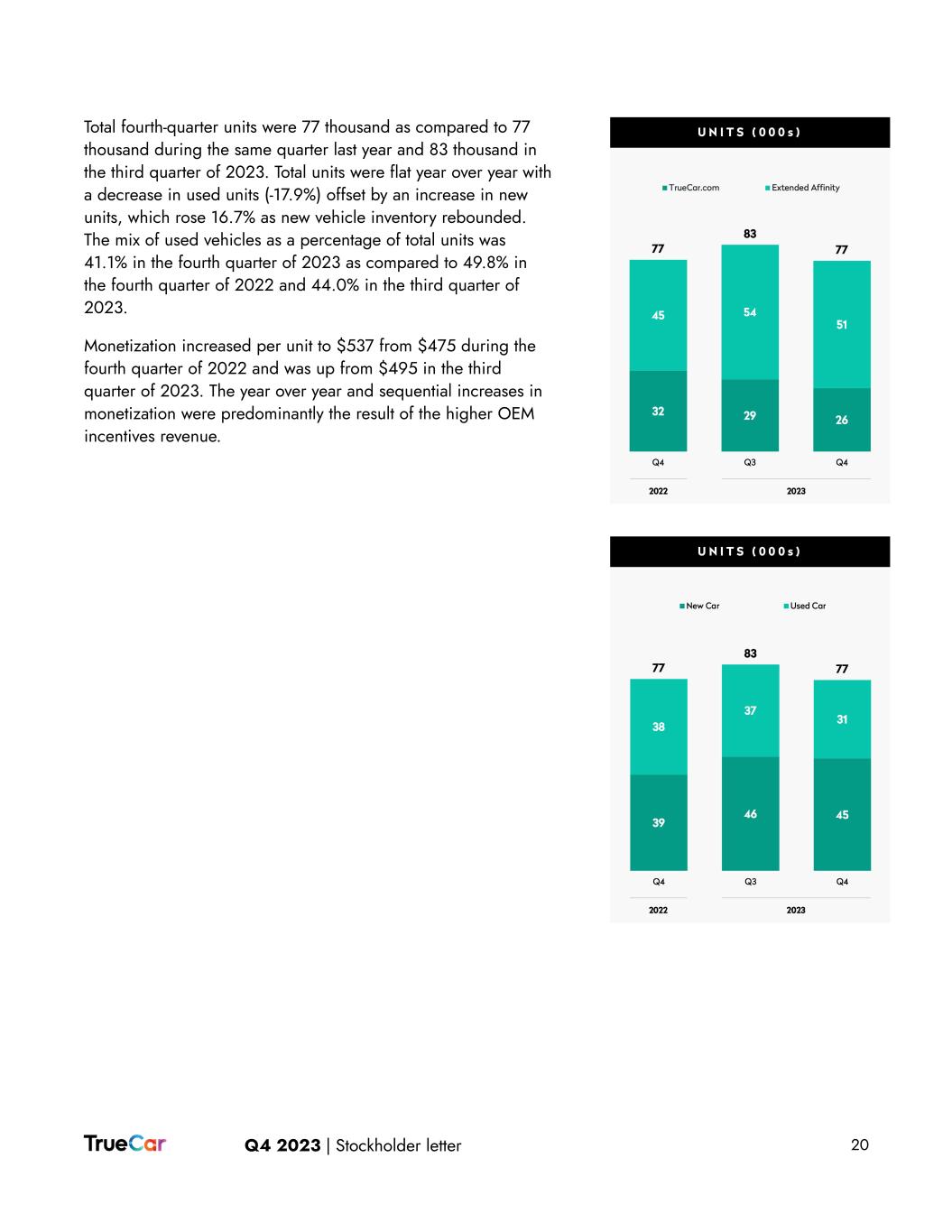
Q4 2023 | Stockholder letter 20 Total fourth-quarter units were 77 thousand as compared to 77 thousand during the same quarter last year and 83 thousand in the third quarter of 2023. Total units were flat year over year with a decrease in used units (-17.9%) offset by an increase in new units, which rose 16.7% as new vehicle inventory rebounded. The mix of used vehicles as a percentage of total units was 41.1% in the fourth quarter of 2023 as compared to 49.8% in the fourth quarter of 2022 and 44.0% in the third quarter of 2023. Monetization increased per unit to $537 from $475 during the fourth quarter of 2022 and was up from $495 in the third quarter of 2023. The year over year and sequential increases in monetization were predominantly the result of the higher OEM incentives revenue.

Q4 2023 | Stockholder letter 21 Expense and Margin (Reconciliations of non-GAAP metrics used in this letter to their nearest GAAP equivalents are provided at the end of this letter under “Financial Statements and Non-GAAP Financial Measures”). Fourth-quarter gross profit, defined as revenues less cost of revenue, was $37.0 million with a gross margin of 89.7% on a GAAP basis, which was slightly down when compared to gross margin of 90.7% in the third quarter of 2023 and 90.3% in the fourth quarter of 2022. The sequential and year over year gross margin decreases were mainly due to TrueCar Wholesale Solutions expenses. Technology and development expenses were $6.9 million on a GAAP basis and $6.4 million on a non-GAAP basis in the fourth quarter of 2023, down 41.1% and 39.5% year over year, respectively. Sequentially, technology and development expenses decreased 26.2% and 14.1% on a GAAP and non-GAAP basis, respectively. The year over year decreases were largely due to lower recurring headcount costs and consulting costs. On a non-GAAP basis, the sequential decreases were primarily a result of lower recurring headcount costs, while on a GAAP basis, reduction in expenses also included significantly lower severance related headcount expenses in the fourth quarter of 2023. General and administrative expenses were $7.2 million on a GAAP basis and $7.0 million on a non-GAAP basis in the fourth quarter of 2023, down 28.4% and 10.3% year over year, respectively. The year over year decreases were largely due to lower recurring headcount costs and consulting costs, however, on a GAAP basis, lower facilities related expenses that resulted from the reduction of our physical footprint also contributed to the scale down in expenses. Sequentially, general and administrative expenses decreased 24.2% on a GAAP basis, yet, increased 2.5% on a non-GAAP basis. The sequential GAAP decreases were mainly the result of lower facilities and reduced severance related headcount expense. On a non-GAAP basis, the sequential increases were largely a result of slightly higher consulting costs.
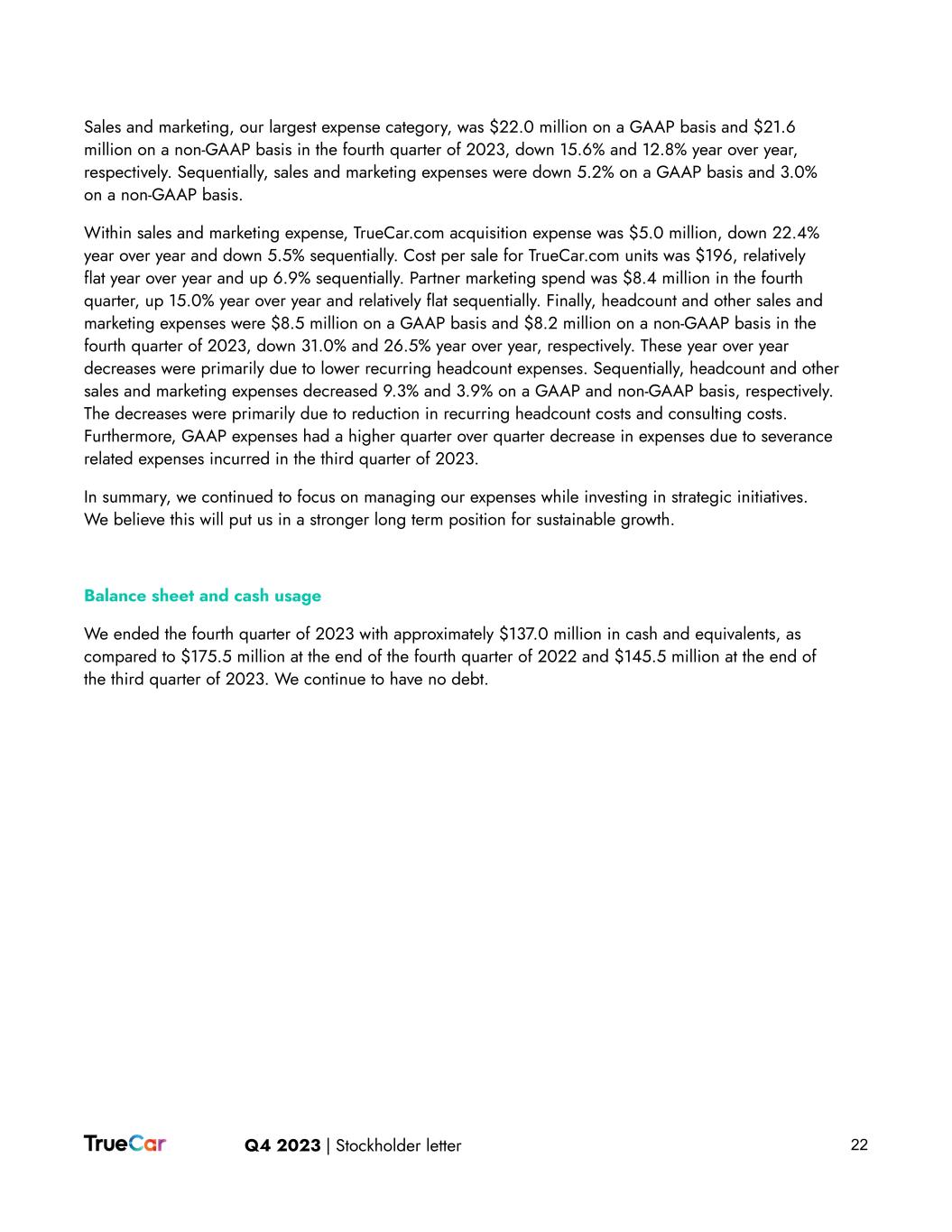
Q4 2023 | Stockholder letter 22 Sales and marketing, our largest expense category, was $22.0 million on a GAAP basis and $21.6 million on a non-GAAP basis in the fourth quarter of 2023, down 15.6% and 12.8% year over year, respectively. Sequentially, sales and marketing expenses were down 5.2% on a GAAP basis and 3.0% on a non-GAAP basis. Within sales and marketing expense, TrueCar.com acquisition expense was $5.0 million, down 22.4% year over year and down 5.5% sequentially. Cost per sale for TrueCar.com units was $196, relatively flat year over year and up 6.9% sequentially. Partner marketing spend was $8.4 million in the fourth quarter, up 15.0% year over year and relatively flat sequentially. Finally, headcount and other sales and marketing expenses were $8.5 million on a GAAP basis and $8.2 million on a non-GAAP basis in the fourth quarter of 2023, down 31.0% and 26.5% year over year, respectively. These year over year decreases were primarily due to lower recurring headcount expenses. Sequentially, headcount and other sales and marketing expenses decreased 9.3% and 3.9% on a GAAP and non-GAAP basis, respectively. The decreases were primarily due to reduction in recurring headcount costs and consulting costs. Furthermore, GAAP expenses had a higher quarter over quarter decrease in expenses due to severance related expenses incurred in the third quarter of 2023. In summary, we continued to focus on managing our expenses while investing in strategic initiatives. We believe this will put us in a stronger long term position for sustainable growth. Balance sheet and cash usage We ended the fourth quarter of 2023 with approximately $137.0 million in cash and equivalents, as compared to $175.5 million at the end of the fourth quarter of 2022 and $145.5 million at the end of the third quarter of 2023. We continue to have no debt.
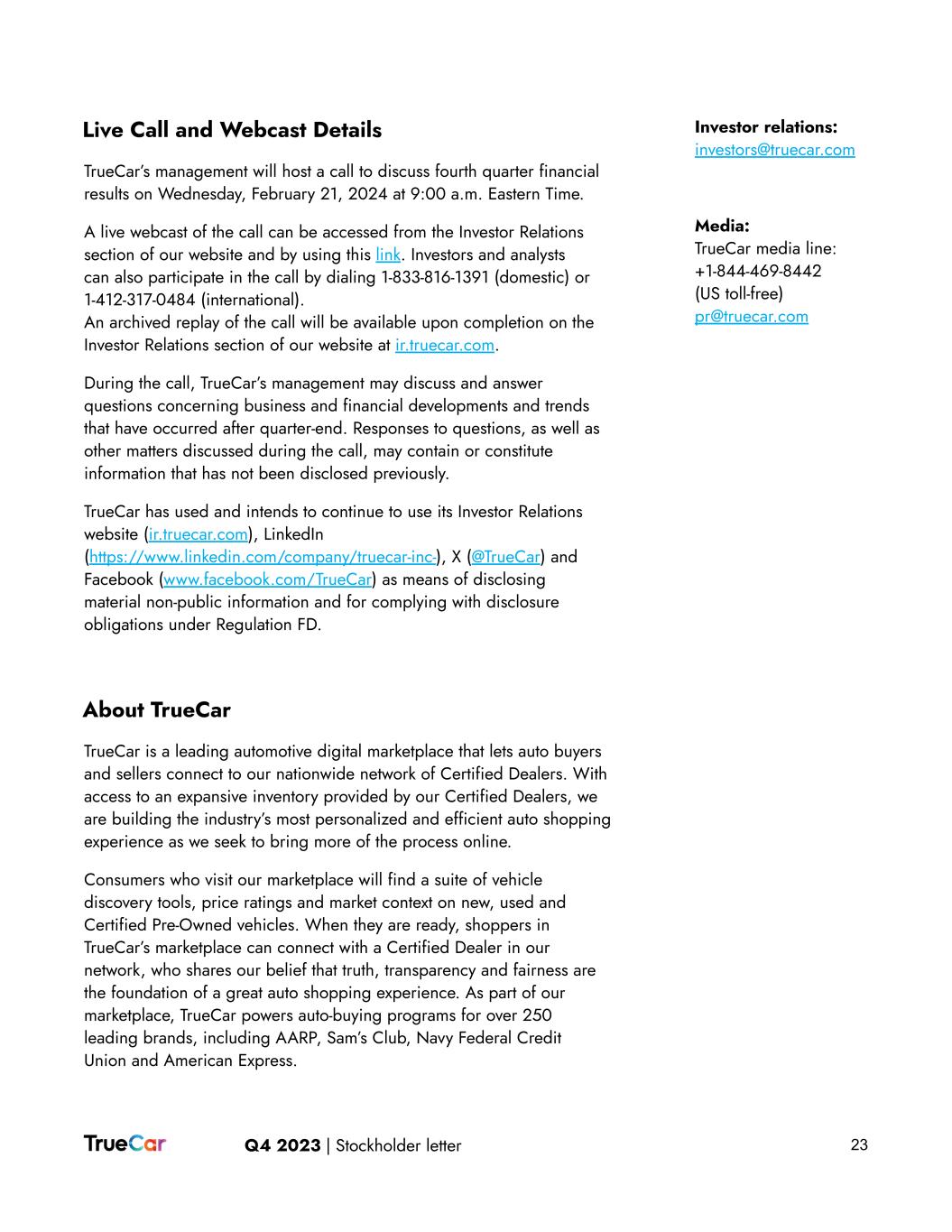
Q4 2023 | Stockholder letter 23 Investor relations: investors@truecar.com Media: TrueCar media line: +1-844-469-8442 (US toll-free) pr@truecar.com Live Call and Webcast Details TrueCar’s management will host a call to discuss fourth quarter financial results on Wednesday, February 21, 2024 at 9:00 a.m. Eastern Time. A live webcast of the call can be accessed from the Investor Relations section of our website and by using this link. Investors and analysts can also participate in the call by dialing 1-833-816-1391 (domestic) or 1-412-317-0484 (international). An archived replay of the call will be available upon completion on the Investor Relations section of our website at ir.truecar.com. During the call, TrueCar’s management may discuss and answer questions concerning business and financial developments and trends that have occurred after quarter-end. Responses to questions, as well as other matters discussed during the call, may contain or constitute information that has not been disclosed previously. TrueCar has used and intends to continue to use its Investor Relations website (ir.truecar.com), LinkedIn (https://www.linkedin.com/company/truecar-inc-), X (@TrueCar) and Facebook (www.facebook.com/TrueCar) as means of disclosing material non-public information and for complying with disclosure obligations under Regulation FD. About TrueCar TrueCar is a leading automotive digital marketplace that lets auto buyers and sellers connect to our nationwide network of Certified Dealers. With access to an expansive inventory provided by our Certified Dealers, we are building the industry’s most personalized and efficient auto shopping experience as we seek to bring more of the process online. Consumers who visit our marketplace will find a suite of vehicle discovery tools, price ratings and market context on new, used and Certified Pre-Owned vehicles. When they are ready, shoppers in TrueCar’s marketplace can connect with a Certified Dealer in our network, who shares our belief that truth, transparency and fairness are the foundation of a great auto shopping experience. As part of our marketplace, TrueCar powers auto-buying programs for over 250 leading brands, including AARP, Sam’s Club, Navy Federal Credit Union and American Express.
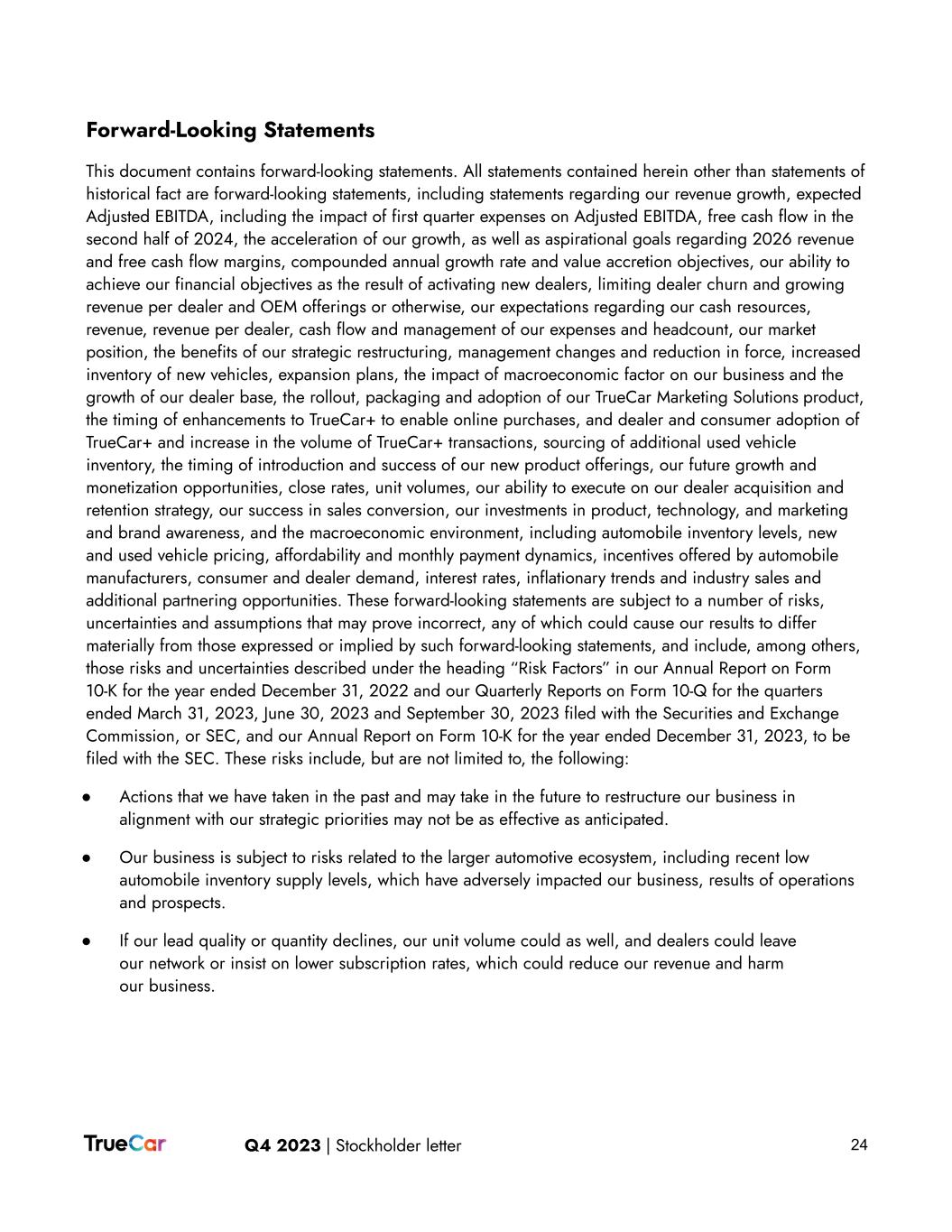
Q4 2023 | Stockholder letter 24 Forward-Looking Statements This document contains forward-looking statements. All statements contained herein other than statements of historical fact are forward-looking statements, including statements regarding our revenue growth, expected Adjusted EBITDA, including the impact of first quarter expenses on Adjusted EBITDA, free cash flow in the second half of 2024, the acceleration of our growth, as well as aspirational goals regarding 2026 revenue and free cash flow margins, compounded annual growth rate and value accretion objectives, our ability to achieve our financial objectives as the result of activating new dealers, limiting dealer churn and growing revenue per dealer and OEM offerings or otherwise, our expectations regarding our cash resources, revenue, revenue per dealer, cash flow and management of our expenses and headcount, our market position, the benefits of our strategic restructuring, management changes and reduction in force, increased inventory of new vehicles, expansion plans, the impact of macroeconomic factor on our business and the growth of our dealer base, the rollout, packaging and adoption of our TrueCar Marketing Solutions product, the timing of enhancements to TrueCar+ to enable online purchases, and dealer and consumer adoption of TrueCar+ and increase in the volume of TrueCar+ transactions, sourcing of additional used vehicle inventory, the timing of introduction and success of our new product offerings, our future growth and monetization opportunities, close rates, unit volumes, our ability to execute on our dealer acquisition and retention strategy, our success in sales conversion, our investments in product, technology, and marketing and brand awareness, and the macroeconomic environment, including automobile inventory levels, new and used vehicle pricing, affordability and monthly payment dynamics, incentives offered by automobile manufacturers, consumer and dealer demand, interest rates, inflationary trends and industry sales and additional partnering opportunities. These forward-looking statements are subject to a number of risks, uncertainties and assumptions that may prove incorrect, any of which could cause our results to differ materially from those expressed or implied by such forward-looking statements, and include, among others, those risks and uncertainties described under the heading “Risk Factors” in our Annual Report on Form 10-K for the year ended December 31, 2022 and our Quarterly Reports on Form 10-Q for the quarters ended March 31, 2023, June 30, 2023 and September 30, 2023 filed with the Securities and Exchange Commission, or SEC, and our Annual Report on Form 10-K for the year ended December 31, 2023, to be filed with the SEC. These risks include, but are not limited to, the following: ● Actions that we have taken in the past and may take in the future to restructure our business in alignment with our strategic priorities may not be as effective as anticipated. ● Our business is subject to risks related to the larger automotive ecosystem, including recent low automobile inventory supply levels, which have adversely impacted our business, results of operations and prospects. ● If our lead quality or quantity declines, our unit volume could as well, and dealers could leave our network or insist on lower subscription rates, which could reduce our revenue and harm our business.
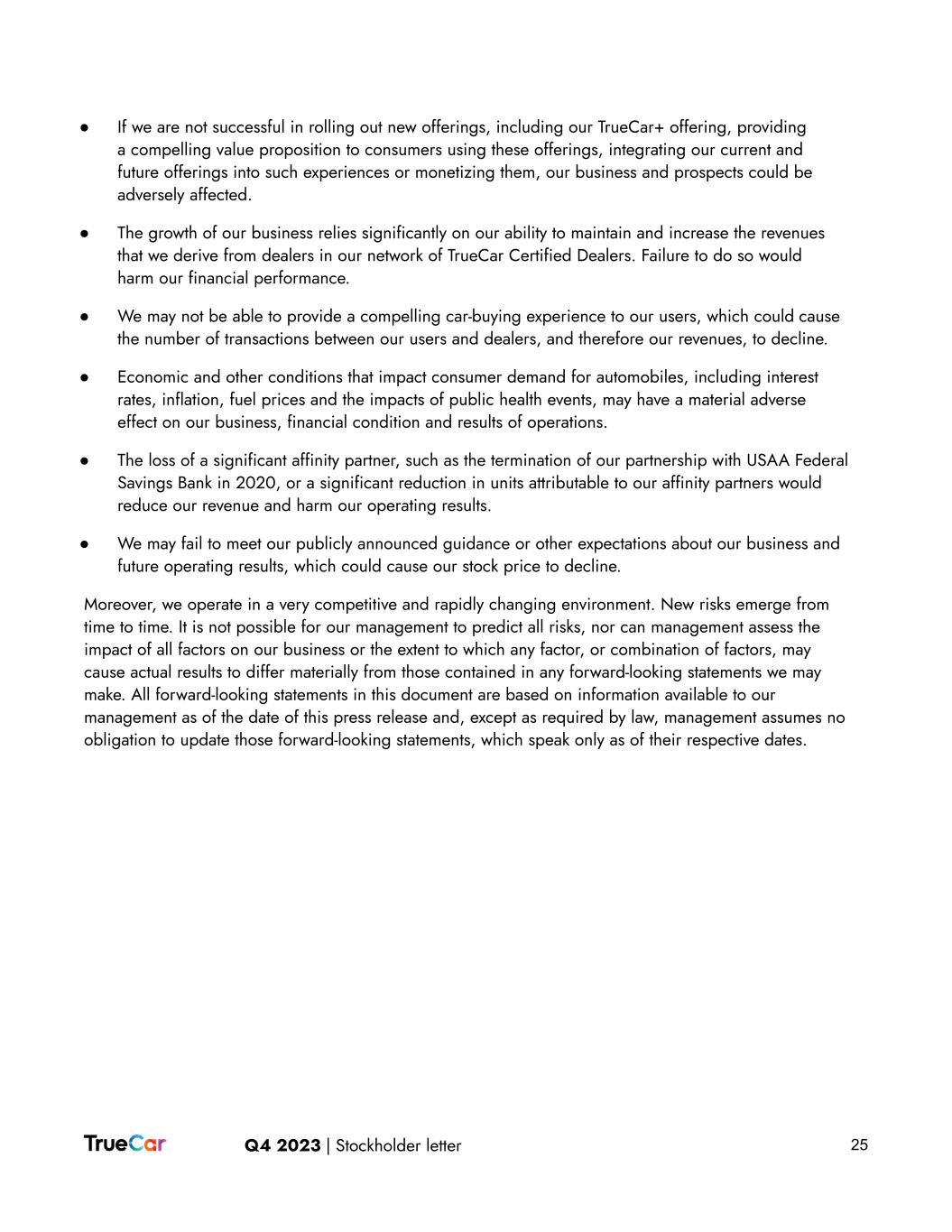
Q4 2023 | Stockholder letter 25 ● If we are not successful in rolling out new offerings, including our TrueCar+ offering, providing a compelling value proposition to consumers using these offerings, integrating our current and future offerings into such experiences or monetizing them, our business and prospects could be adversely affected. ● The growth of our business relies significantly on our ability to maintain and increase the revenues that we derive from dealers in our network of TrueCar Certified Dealers. Failure to do so would harm our financial performance. ● We may not be able to provide a compelling car-buying experience to our users, which could cause the number of transactions between our users and dealers, and therefore our revenues, to decline. ● Economic and other conditions that impact consumer demand for automobiles, including interest rates, inflation, fuel prices and the impacts of public health events, may have a material adverse effect on our business, financial condition and results of operations. ● The loss of a significant affinity partner, such as the termination of our partnership with USAA Federal Savings Bank in 2020, or a significant reduction in units attributable to our affinity partners would reduce our revenue and harm our operating results. ● We may fail to meet our publicly announced guidance or other expectations about our business and future operating results, which could cause our stock price to decline. Moreover, we operate in a very competitive and rapidly changing environment. New risks emerge from time to time. It is not possible for our management to predict all risks, nor can management assess the impact of all factors on our business or the extent to which any factor, or combination of factors, may cause actual results to differ materially from those contained in any forward-looking statements we may make. All forward-looking statements in this document are based on information available to our management as of the date of this press release and, except as required by law, management assumes no obligation to update those forward-looking statements, which speak only as of their respective dates.
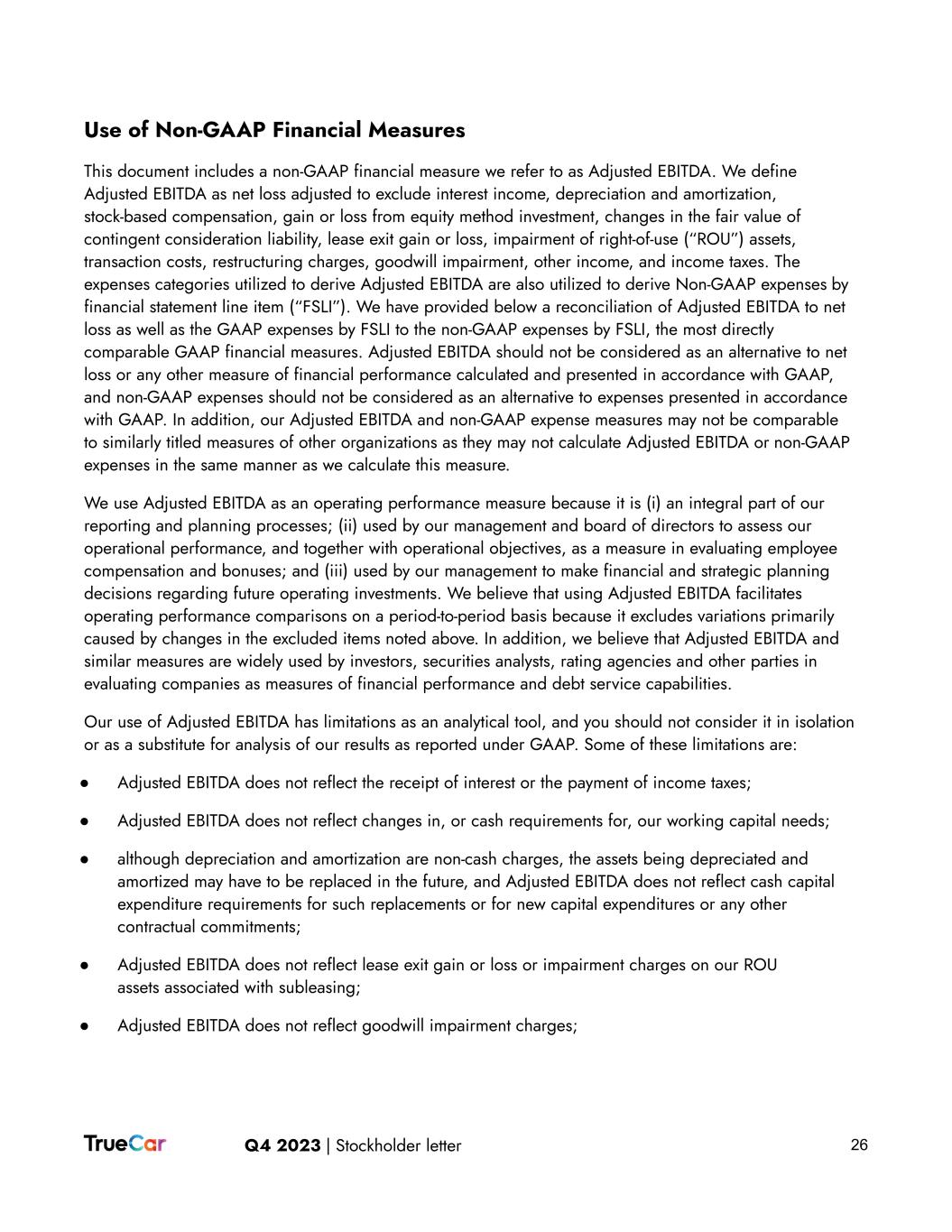
Q4 2023 | Stockholder letter Use of Non-GAAP Financial Measures This document includes a non-GAAP financial measure we refer to as Adjusted EBITDA. We define Adjusted EBITDA as net loss adjusted to exclude interest income, depreciation and amortization, stock-based compensation, gain or loss from equity method investment, changes in the fair value of contingent consideration liability, lease exit gain or loss, impairment of right-of-use (“ROU”) assets, transaction costs, restructuring charges, goodwill impairment, other income, and income taxes. The expenses categories utilized to derive Adjusted EBITDA are also utilized to derive Non-GAAP expenses by financial statement line item (“FSLI”). We have provided below a reconciliation of Adjusted EBITDA to net loss as well as the GAAP expenses by FSLI to the non-GAAP expenses by FSLI, the most directly comparable GAAP financial measures. Adjusted EBITDA should not be considered as an alternative to net loss or any other measure of financial performance calculated and presented in accordance with GAAP, and non-GAAP expenses should not be considered as an alternative to expenses presented in accordance with GAAP. In addition, our Adjusted EBITDA and non-GAAP expense measures may not be comparable to similarly titled measures of other organizations as they may not calculate Adjusted EBITDA or non-GAAP expenses in the same manner as we calculate this measure. We use Adjusted EBITDA as an operating performance measure because it is (i) an integral part of our reporting and planning processes; (ii) used by our management and board of directors to assess our operational performance, and together with operational objectives, as a measure in evaluating employee compensation and bonuses; and (iii) used by our management to make financial and strategic planning decisions regarding future operating investments. We believe that using Adjusted EBITDA facilitates operating performance comparisons on a period-to-period basis because it excludes variations primarily caused by changes in the excluded items noted above. In addition, we believe that Adjusted EBITDA and similar measures are widely used by investors, securities analysts, rating agencies and other parties in evaluating companies as measures of financial performance and debt service capabilities. Our use of Adjusted EBITDA has limitations as an analytical tool, and you should not consider it in isolation or as a substitute for analysis of our results as reported under GAAP. Some of these limitations are: ● Adjusted EBITDA does not reflect the receipt of interest or the payment of income taxes; ● Adjusted EBITDA does not reflect changes in, or cash requirements for, our working capital needs; ● although depreciation and amortization are non-cash charges, the assets being depreciated and amortized may have to be replaced in the future, and Adjusted EBITDA does not reflect cash capital expenditure requirements for such replacements or for new capital expenditures or any other contractual commitments; ● Adjusted EBITDA does not reflect lease exit gain or loss or impairment charges on our ROU assets associated with subleasing; ● Adjusted EBITDA does not reflect goodwill impairment charges; 26
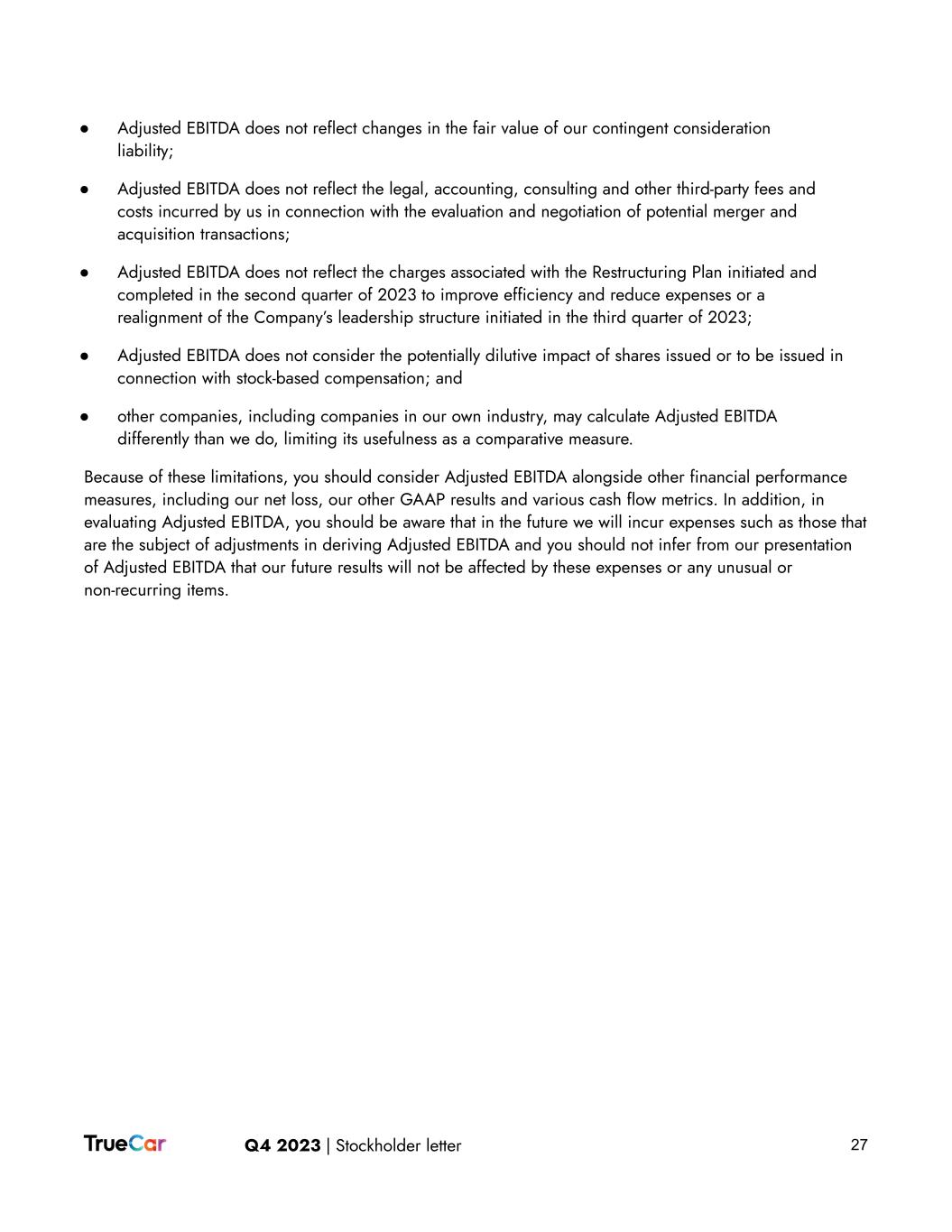
Q4 2023 | Stockholder letter 27 ● Adjusted EBITDA does not reflect changes in the fair value of our contingent consideration liability; ● Adjusted EBITDA does not reflect the legal, accounting, consulting and other third-party fees and costs incurred by us in connection with the evaluation and negotiation of potential merger and acquisition transactions; ● Adjusted EBITDA does not reflect the charges associated with the Restructuring Plan initiated and completed in the second quarter of 2023 to improve efficiency and reduce expenses or a realignment of the Company’s leadership structure initiated in the third quarter of 2023; ● Adjusted EBITDA does not consider the potentially dilutive impact of shares issued or to be issued in connection with stock-based compensation; and ● other companies, including companies in our own industry, may calculate Adjusted EBITDA differently than we do, limiting its usefulness as a comparative measure. Because of these limitations, you should consider Adjusted EBITDA alongside other financial performance measures, including our net loss, our other GAAP results and various cash flow metrics. In addition, in evaluating Adjusted EBITDA, you should be aware that in the future we will incur expenses such as those that are the subject of adjustments in deriving Adjusted EBITDA and you should not infer from our presentation of Adjusted EBITDA that our future results will not be affected by these expenses or any unusual or non-recurring items.
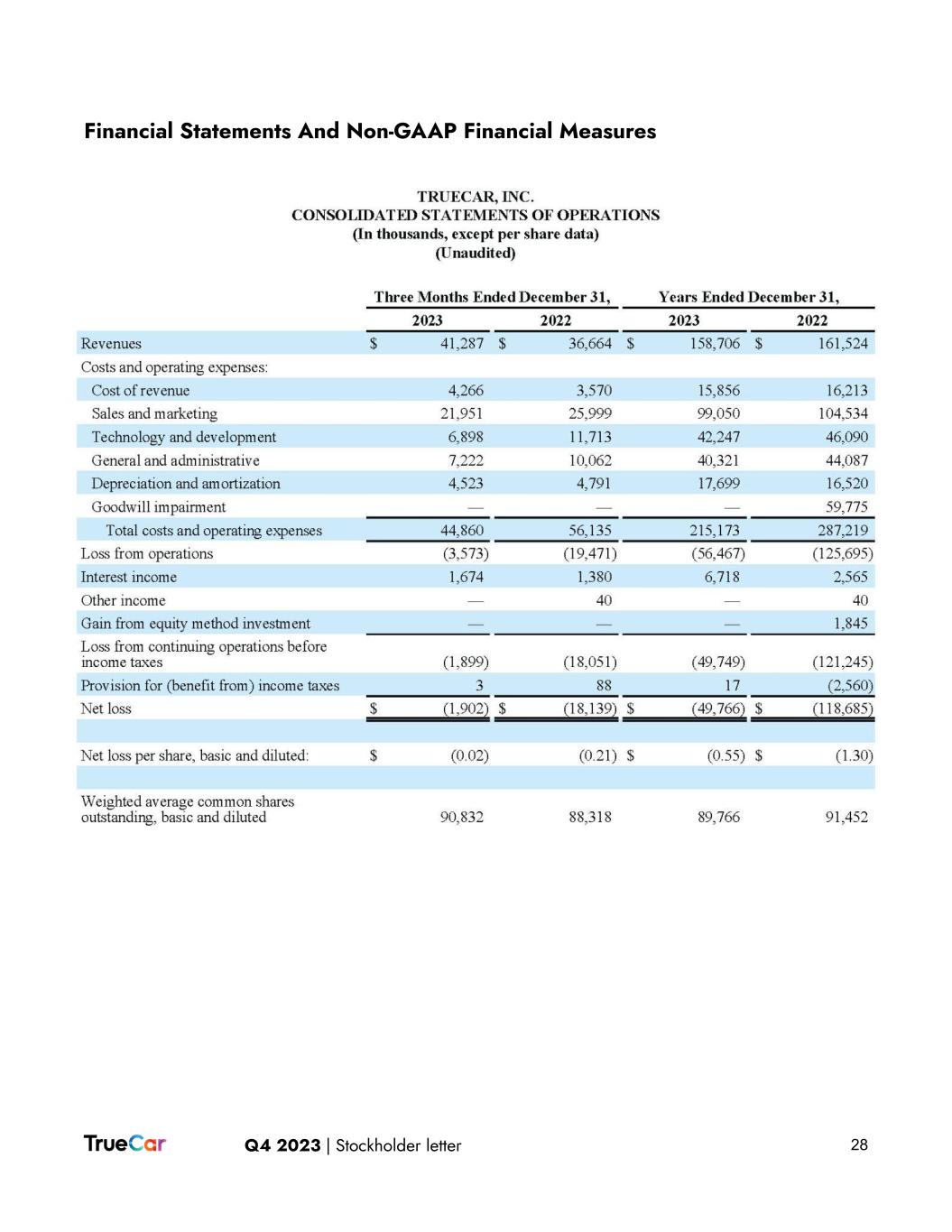
Q4 2023 | Stockholder letter 28 Financial Statements And Non-GAAP Financial Measures
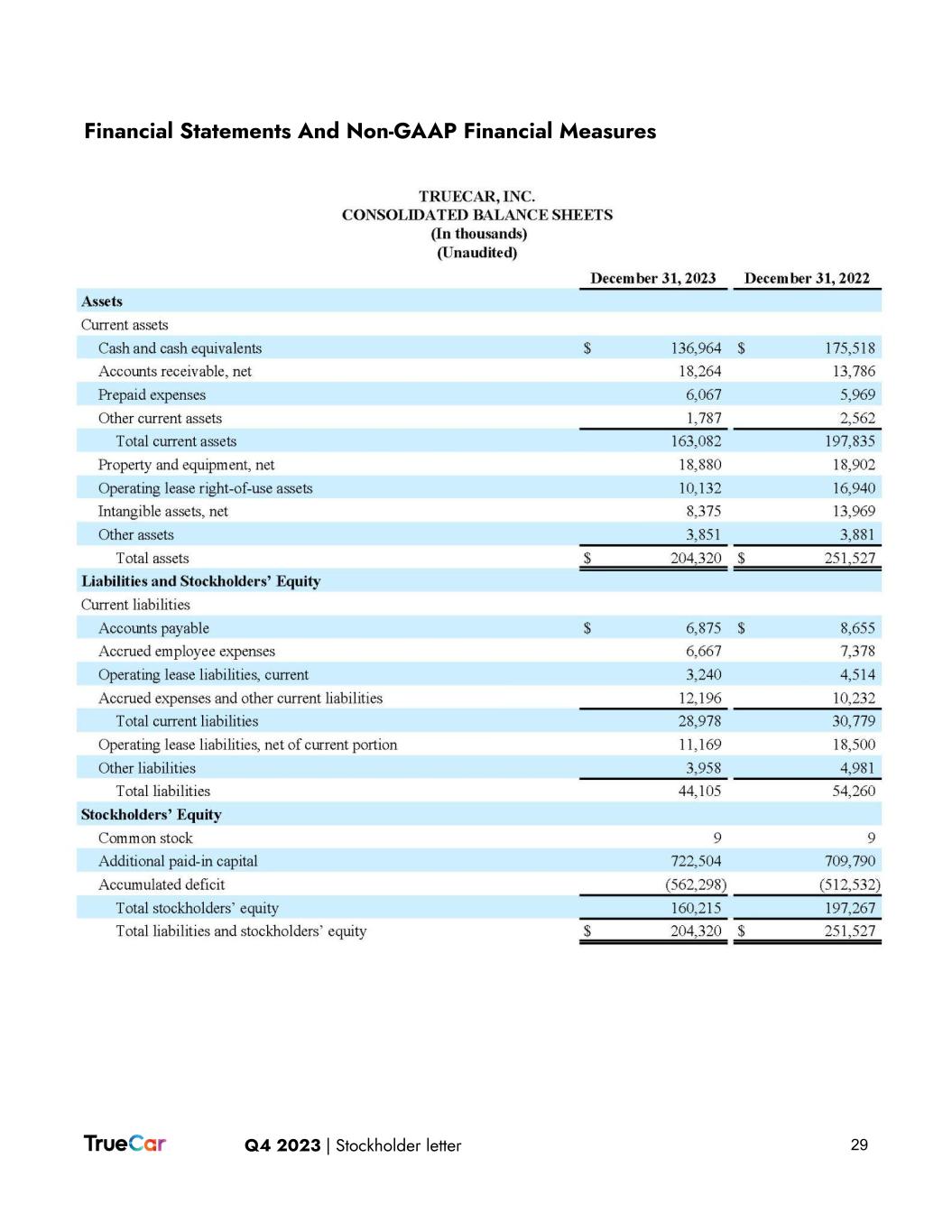
Q4 2023 | Stockholder letter 29 Financial Statements And Non-GAAP Financial Measures
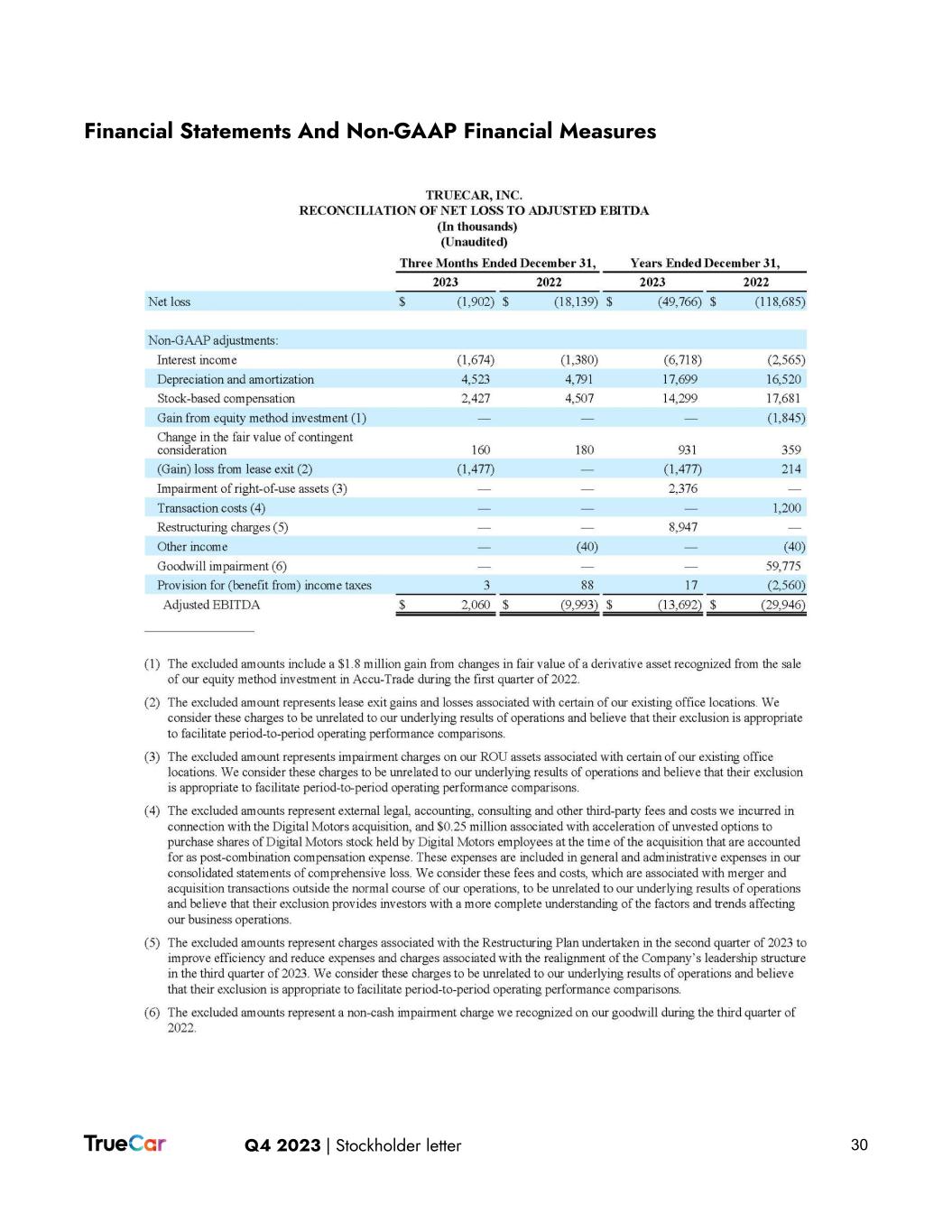
Q4 2023 | Stockholder letter 30 Financial Statements And Non-GAAP Financial Measures
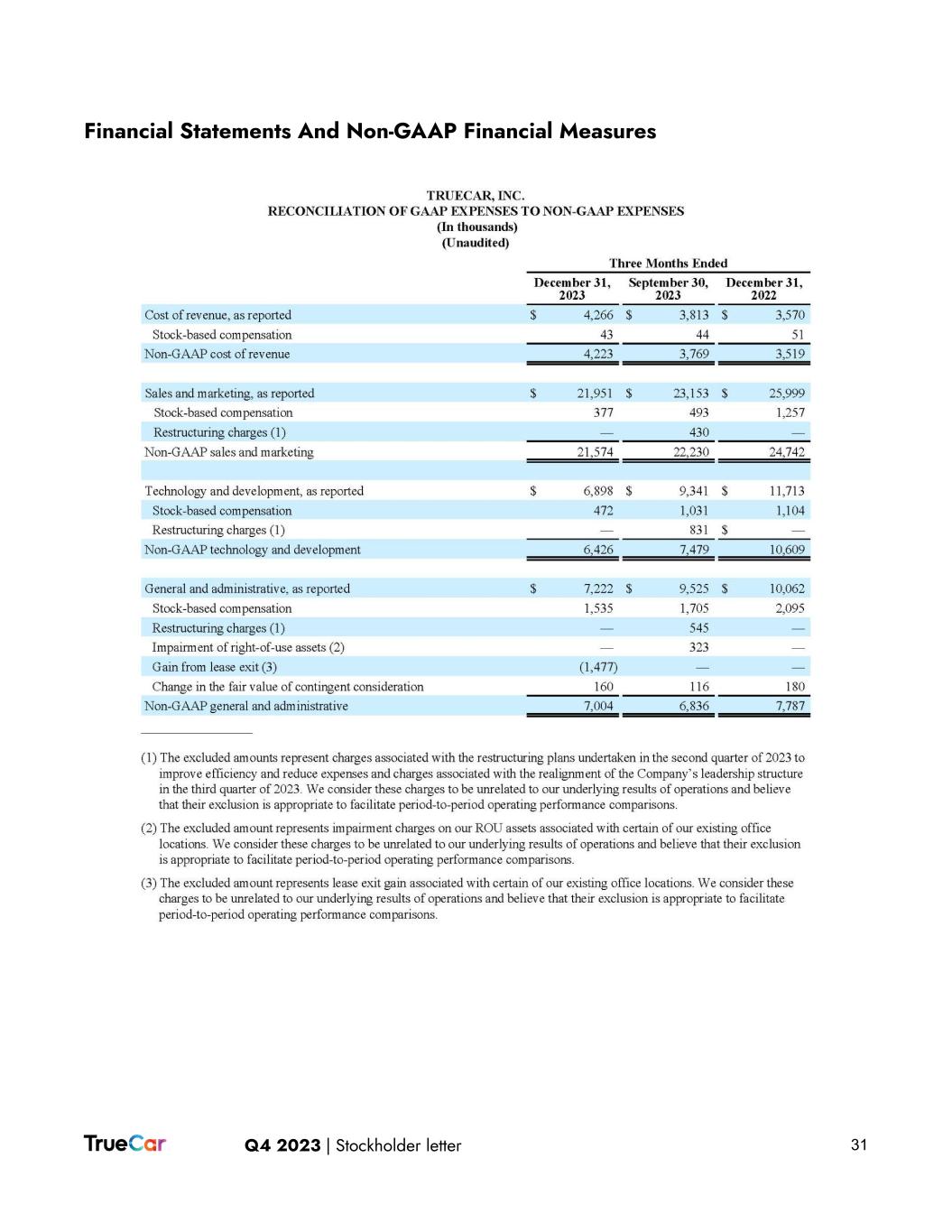
Q4 2023 | Stockholder letter 31 Financial Statements And Non-GAAP Financial Measures

Thank You